- Skip to main content
- Skip to primary sidebar

Wilderness Inquiry
Share the adventure!

We're happy to answer any questions you have!
- Name * First Last
- Comment or Question(s)? *
- Subscribe to News and Updates
- Are you a robot?
- Comments This field is for validation purposes and should be left unchanged.

Boundary Waters Canoe Area
Paddle million-acre wilderness.
The Boundary Waters Canoe Area Wilderness is America’s premier canoe destination. It is also one of the most accessible wilderness areas in the United States, and where Wilderness Inquiry began operating in the 1970s. Over one million acres in size, the Boundary Waters covers much of the Superior National Forest in northeastern Minnesota. Paddle among towering pines in the home of moose, lynx, wolves, and bald eagles.
Every Wilderness Inquiry trip ensures your adventure is the best it can be. Decades of experience in combination with top notch food and gear make Wilderness Inquiry BWCA trips an exceptional value. Our classic 5-day Boundary Waters Canoe Area Paddle Adventure is the quintessential guided canoe trip . Paddle lightweight Wenonah kevlar canoes and camp in beautiful lakeside campsites. The Boundary Waters lodge based adventure is based out of stunning Wintergreen Lodge on White Iron Lake. From here, you’ll enjoy excellent BWCA day trips off the Kawishiwi River or the Fernberg Trail, returning to delicious meals, a glass of wine, and a comfortable bed at night. The Boundary Waters Family Canoe and Hike trip is geared for families and based at a Forest Service campsite, allowing us to do day trips in smaller groups into the Wilderness. Our Boundary Waters Winter Adventure changes it up for winter fun at Camp Menogyn on West Bearskin Lake. You will love dogsledding, skiing, and seeing the Wilderness dressed in its winter clothes.
Whatever Boundary Waters trip you choose, we know you will enjoy this iconic wilderness area and come to understand why it is beloved by so many.
View by Itinerary
View by date.
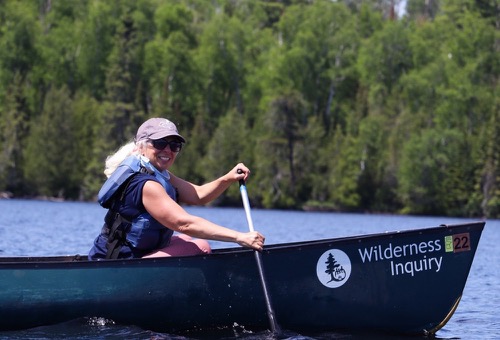
Boundary Waters Canoe Area Paddle Adventure
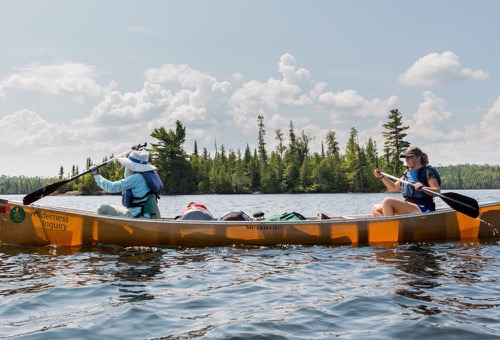
Boundary Waters Base Camp Adventure
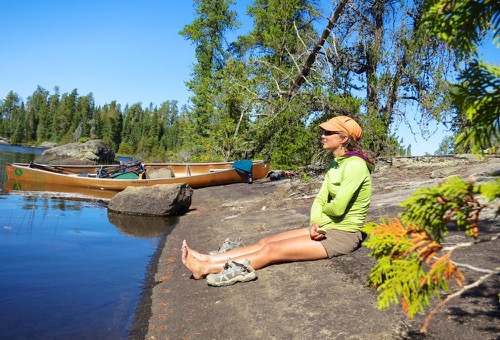
Boundary Waters Canoe Area Expedition
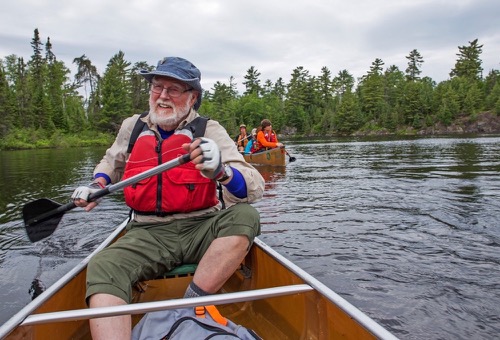
Boundary Waters Lodge-Based Adventure
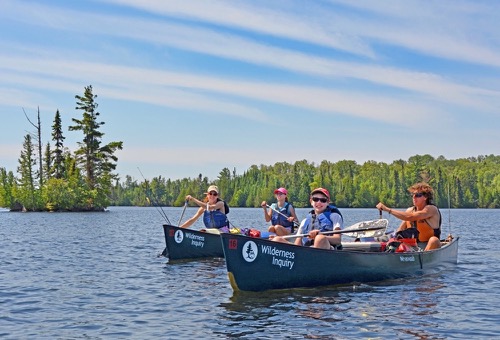
Boundary Waters Family Canoe and Hike
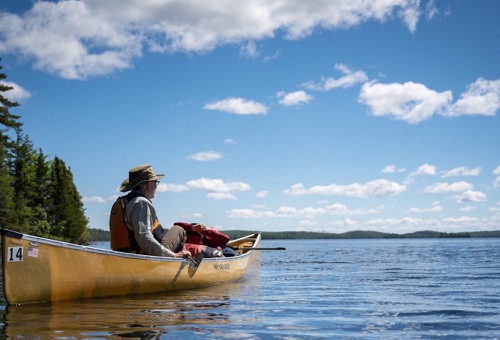
Boundary Waters Lodge-Based Reader’s Retreat with William Kent Krueger
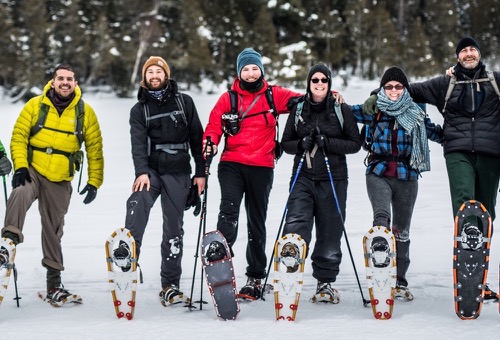
Boundary Waters Winter Adventure
About the area.
In 1964, Congress designated the BWCA as one of the first federally protected wilderness areas in the United States as part of the National Wilderness Preservation System. The BWCA, the northern third of Superior National Forest, lies on the international border between northern Minnesota and the Province of Ontario, Canada. Together, with the adjoining 1.2 million-acre Quetico Provincial Park on the Ontario side of the border, this international wilderness complex forms an unparalleled lakeland complex of 2.3 million acres, an area larger than Yellowstone.
Sculpted by glaciation, the area is part of the Canadian Shield, a geological formation that comprises portions of the earth’s most ancient exposed rock, some of which is 3 billion years old! The Boundary Waters contains about 1,175 lakes in all, creating a maze of interconnected wilderness waterways to explore. Whether you paddle one of the larger border lakes – Saganaga, Knife, Basswood, Crooked, Lac La Croix – or one of the smaller more intimate lakes, you’ll experience an undeveloped wilderness that appears much the same as it has for hundreds of years. Each lake brings its own distinct personality and you may find you and your canoeing partners each have a different favorite.
Two types of forests, the Boreal and Laurentian forests, converge to create a unique ecosystem with diverse plant and animal life in the Boundary Waters. Animals that would not normally be seen together, such as the white-tailed deer and the moose, have made the BWCA their homes. Many birds, such as bald eagles & loons, and over 20 species of wood warblers, use the Boundary Waters as their nesting grounds. Anglers can test their skills against the area’s lake trout, walleye, northern pike, or small and largemouth bass.
Humans have left their mark on the Boundary Waters as well. Native peoples inhabited the Boundary Waters area for thousands of years, with some human relics dating back to 10,000 BC. The Anishinabe (sometimes called Ojibwe, or Chippewa) and Dakota (Sioux) used the intricate waterways of the BWCA for hundreds of years. Native peoples first used many of the campsites and portages (paths between lakes) still used today. Artifacts from that period can still be found on occasion. European fur traders and missionaries first came into the area in the early 1700s. A working relationship developed between the European fur traders and the Ojibwe, based on trade of European goods for native knowledge and furs. This partnership ended in the mid 19th century due to the declining interest in furs as fashion.
Fur trading and logging of the Boundary Waters began taking its toll on the fragile ecosystem. People decided to act, setting aside this pristine area and working to protect it from further harm. In 1909, President Teddy Roosevelt established the Superior National Forest, with 1,000 square miles of roadless land (the precursor to the BWCA) later set aside in 1926 as the nation’s second administratively-established wilderness. The 1964 Wilderness Act designated the Boundary Waters as an original unit of the National Wilderness Preservation System, but with some compromises that allowed logging and motorboats to continue there. Congress passed additional protections for the BWCA in 1978, and expanded the area to its current borders and size of 1.1 million acres. The controversy surrounding this Congressional effort for the Boundary Waters also led to the establishment of Wilderness Inquiry; WI began by taking canoe trips in the BWCA and continues doing so to this day.
The Boundary Waters is one of National Geographic Traveler magazine’s “50 Places of a Lifetime.” Situated within Superior National Forest in northeastern Minnesota, the Boundary Waters Canoe Area Wilderness is a vast preserve of lakes and woods that stretches for about 100 miles along the U.S. border with Canada. Spread within the Boundary Waters are over 1,500 miles of canoe routes over more than 1,000 lakes, rivers and streams linked by trails called “portages.”
Due to strict permitting and non-motorized status the wilderness is yours to explore without people or vehicles. These factors contribute to the serenity of the area creating the perfect location for canoeing.
Camping for families
The wilderness is and ideal setting for families. Without the noise of daily life expect to learn more about yourselves and each other. The Boundary Waters Family Canoe and Hike trip is geared for families and based at a Forest Service campsite, allowing us to do day trips in smaller groups into the Wilderness.
Adventurers
Our classic 5-day Boundary Waters Canoe Area Paddle Adventure is the quintessential guided canoe trip for adventurers of all ability levels. Our experienced guides will teach you basic paddle strokes, the art of portaging a canoe, and can help you find a new appreciation for the great Northwoods.
Prove It First: Commonsense Protection For The Boundary Waters & Lake Superior. Take Action
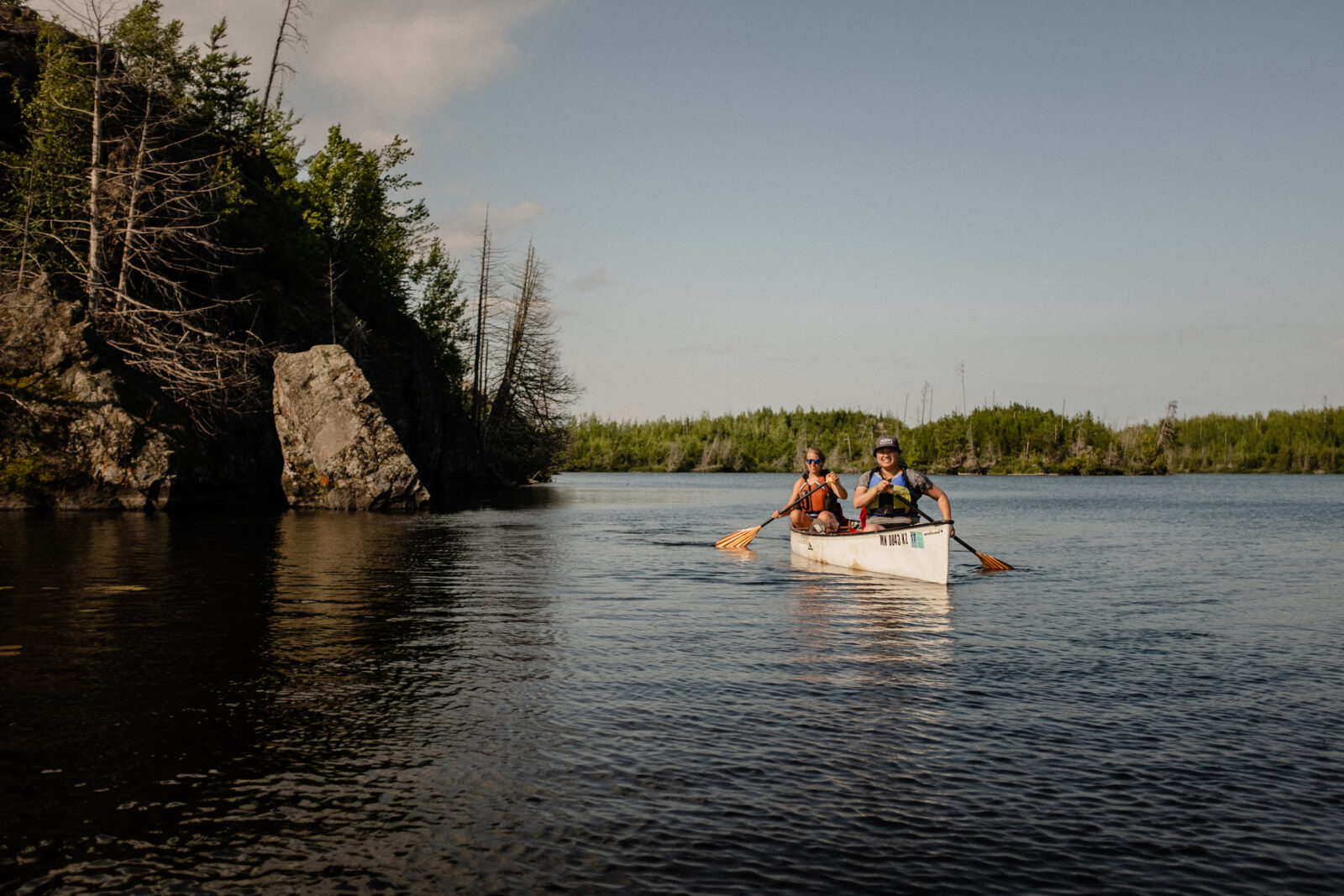
Plan a Boundary Waters Trip
Need inspiration for your next adventure? Want to canoe the Boundary Waters but not sure where to begin? You’ve come to the right place!
Decide What Type of Trip to Take
There are many ways to explore the Boundary Waters, but the two most popular modes of travel are hiking and canoeing.
Northeastern Minnesota is created for canoeing. This is the best canoe country in the United States, a place where each year thousands of lives are transformed.
A number of rugged wilderness trails wind through canoe country, challenging the stamina and navigational skills of even seasoned backpackers.
Pick a Time of Year
From Memorial Day through Labor Day, the Boundary Waters becomes a destination for adventure seekers and those looking to relax, fish, and discover the wonder of this national treasure.
Crisp weather, stunning colors, fewer people and no bugs. There’s a reason people pick fall to get their Boundary Waters fix!
Once the lakes freeze, people exchange their paddles and canoes for snowshoes and dogsleds. Those who embrace the cold are rewarded by unmatched beauty, silence and wonder.
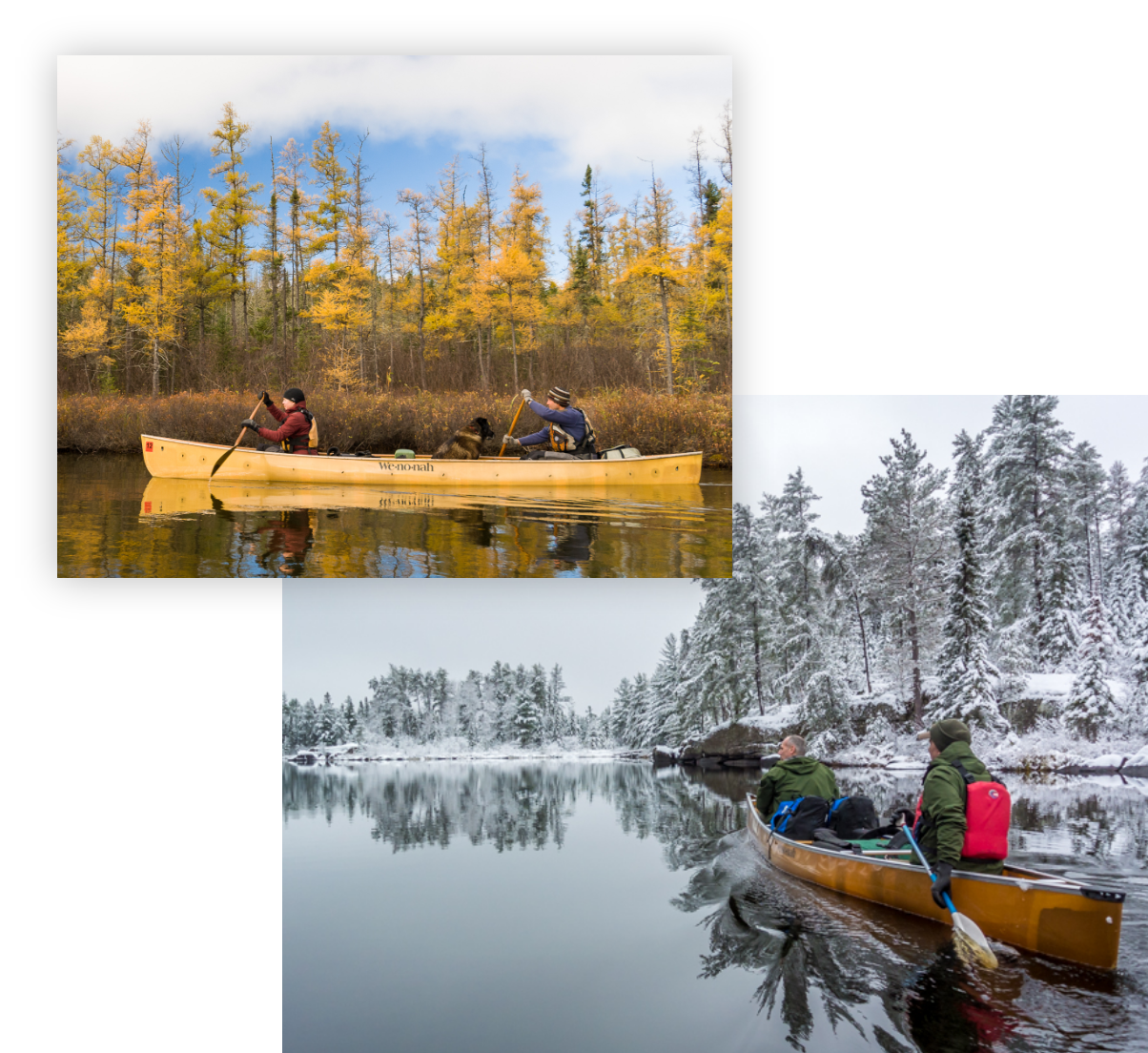
Select Your Route
Our interactive route-finding tool makes it easy to find your next adventure. With 1,200 miles of canoe routes and endless options of where to go, what lakes to visit and which portages to take, you’ll need a couple lifetime’s worth of paddling before you get bored.
Reserve Your Permit
From May 1 to September 30, if you plan on any kind of overnight visit to the Boundary Water (backpacking, canoeing or otherwise) you need to obtain a quota permit. They go quickly, so reserve yours in advance!
Continue Preparing for Your Boundary Waters Trip


How to Plan a Boundary Waters Canoe Trip in Minnesota
Start planning your Minnesota Boundary Waters canoe trip with this complete guide including BWCA entry points, Boundary Water camping, & more

Find this post helpful? Learn how you can support Bearfoot Theory’s work here . You can also shop for gear through the affiliate links in this blog post where we get a small commission at no cost to you. It helps keep our team running and the lights on. THANK YOU! -Kristen
Planning a Boundary Waters canoe trip in the Boundary Waters Canoe Area Wilderness (BWCA) involves navigating a labyrinth of over 1,000 lakes and islands. Located on the Minnesota/Canada border, I’ve made countless trips to the BWCA ever since I was a kid and it always delivers when I want a quiet week filled with great views and adventure.
The BWCA is the most-visited wilderness area in the U.S. and for good reason. From short overnight trips to multi-week remote adventures, the BWCA offers a unique camping experience for all skill levels. Like most remote camping trips, though, canoeing the BWCA requires planning in order to secure permits, learn how to navigate lakes and make portages, and assemble the right gear for a successful trip. I’ve made many trips to the BWCA, so in this post, I’m sharing all the important tips and guidance you’ll need to have a successful trip in Minnesota’s great north woods.
In this Boundary Waters canoe trip guide, I share everything you need to know to plan your own canoeing adventure to this amazing and remote area.
Important Reminder: As outdoor recreationists, it’s our responsibility to know how to recreate responsibly on the water whether we’re kayaking, paddleboarding, canoeing, rafting, or boating. Learn how to prevent the spread of aquatic invasive species with 3 easy steps that have a huge impact on our ecosystems.
Best Time to Canoe the Boundary Waters
Since the lakes freeze over in the winter, the best time to canoe the Boundary Waters is between spring, summer, and fall. Typically May through October is the canoeing season.
The summer months are the popular time to go, especially the back half of August. The water is warm enough to swim in and the weather gets up into the 70s and 80s. The main downside to canoeing in the summer months, however, is that mosquitoes and biting flies can put a huge damper on your trip. Bugs peak in mid-June and while the black flies last a week or two, the mosquitos stick around all summer. People share horror stories about the mosquitos, but truthfully they’re not much different than anywhere else in the Midwest.
Visiting during the spring is constrained to the month of May since the lake ice usually doesn’t melt until then. It’s a great month for fishing, solitude, and returning animals and birds, but it can be cold — lows are typically in the 40s.
Fall is one of the best times to visit the BWCA. There are fewer or no bugs, the crowds are basically gone, the fish are returning to the shallow water, and the fall colors are changing. Camping from mid-September to mid-October is the best time to visit if you want to catch the fall foliage as the aspen, birch, and maples leaves begin turning red, orange, and yellow. Make sure to check out these fall camping tips if you plan to visit during this season.
No matter what time of year you visit, it’s important to be prepared for cold temperatures, rainy weather, or submerged and wet gear. Always pack extra warm layers and don’t use cotton.

Planning Your BWCA Route
Bwca entry points.
There are two main BWCA entry points to start your trip: Ely and the Gunflint Trail . In general, the Ely area is quite wooded and has old-growth tree stands you can camp near. Visitors starting in the Gunflint area are likely to see the effects of fires and blowdowns, but while some forests in this area seem more sparse, there’s a more remote, rugged quality to this terrain.
I’ve done a handful of canoe trips out of Ely, but I prefer the Gunflint area for starting a trip because you immediately enter into wilderness with a rugged character.
BWCA Portages
If you’ve never been to the Boundary Waters before, it’s possible you’ve never had to portage a canoe before. Simply put, a portage is when you pick your canoe up and move it overland from one lake to another. The BWCA has over 1,000 lakes connected by portage paths of varying lengths — the shorter and fewer of them on your route, the easier it will be.
Portages are typically measured in rods, which is 16.5 feet long, roughly the length of your canoe. Portaging a canoe isn’t as hard as it seems and it’s actually easy to pick up and carry a canoe by yourself. It has more to do with skill than strength — forget the methods that have you quickly lift the canoe overhead like a powerlifter. Simply follow this method for picking up and carrying the canoe . I’ve seen retired folks do this in the BWCA with no problem at all.
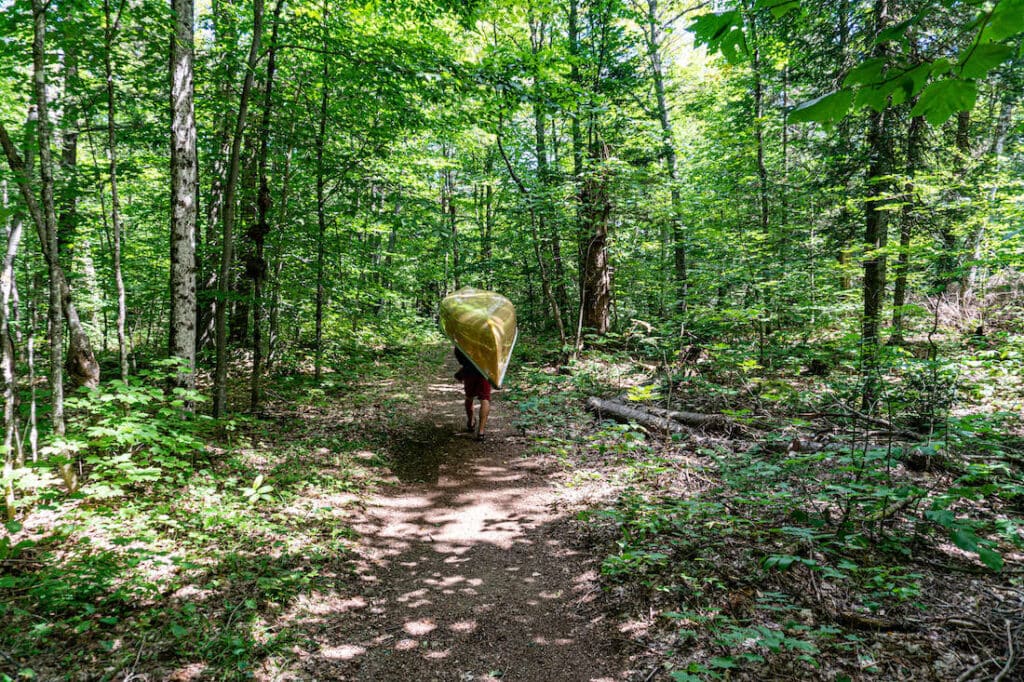
Boundary Waters Route Options
My favorite BWCA route is starting off at the Gunflint Trail at Saganaga Lake and canoeing to Red Rock Lake, Alpine Lake, and Sea Gull Lake to loop back to the start.
There are lots of different route options, though, and you can’t go wrong using the Trip Planner from the Friends of the Boundary Waters Wilderness (more on them later) to cater the route to your trip. You can choose different routes depending on your timeframe, how many portages you’d like to take, how long you want to paddle each day, and your current skill level.
Boundary Waters canoe rentals & Outfitters
While some people bring their own canoes to the BWCA, there are plenty of Boundary Waters canoe rental outfitters in both Ely and the Gunflint Trail. Not only are they inexpensive, but the guides here are a wealth of knowledge for planning your trip, asking questions, and getting some great beta on the best swimming spots and fishing holes. I’ve had great experiences with Voyageur Canoe Outfitters .
Keep in mind that the BWCA is a very large wilderness area, and with so many lakes and islands, you could spend a lifetime exploring different routes. No matter if you choose Ely or Gunflint as your Boundary Waters entry point, you’re going to have a blast.
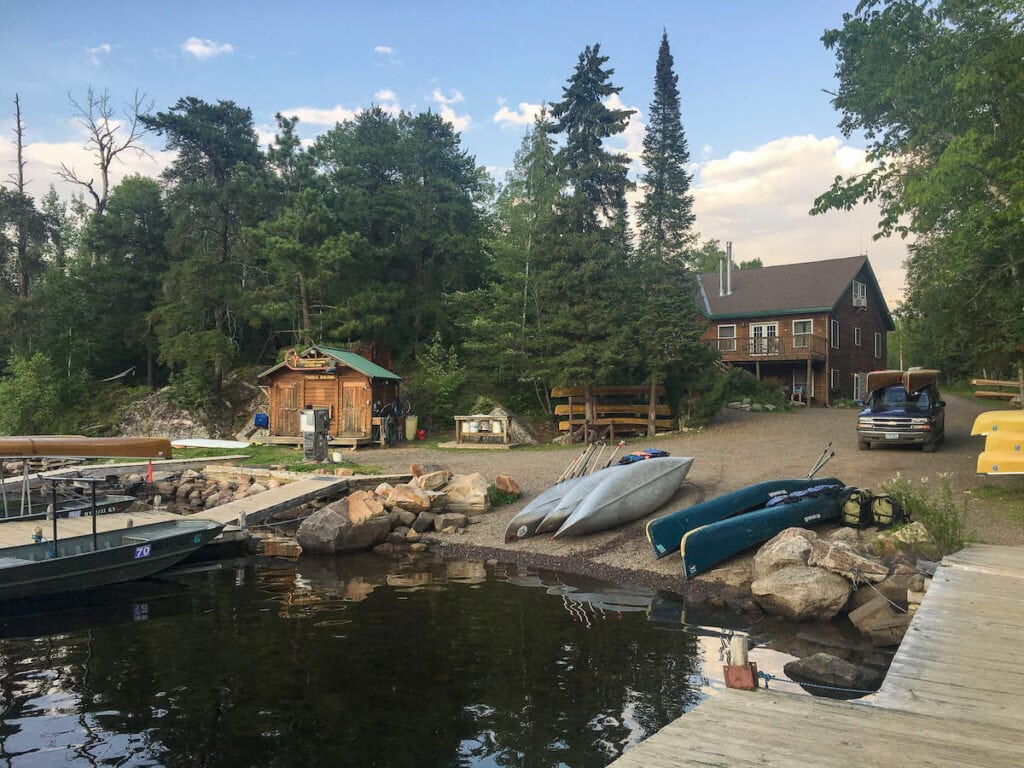
BWCA Permits
Once you’ve decided on where you want to start your trip, you’ll have to secure a BWCA permit. Permits are required for overnight trips from May 1 to September 30 . Walk-up permits are available the day of and the day before your trip, but their availability is not guaranteed. Keep in mind you don’t need to know exactly how many days or how many people are in your party to reserve a permit.
One Boundary Waters permit allows a group of up to 9 people and 4 watercraft to enter the wilderness . You can’t exceed the group limit at any time on water or land. Fees are $16 per adult per trip ($8 per kid per trip), and there’s also a non-refundable $6 reservation fee.
If you plan on fishing, obtain your fishing license before your trip either online or at any gas station/bait shop across the state. If you’re a Minnesota resident, an annual fishing license is $25 or $14 for 72 hours. If you’re a non-resident, it’s $51 annually, $43 for 7 days, or $36 for 72 hours.
The reservation system for Boundary Waters permits opens up at 9 a.m. CT on the last Wednesday of January every year on the BWCA recreation.gov website . If you plan on canoeing outside of the May-September season, you do not need a permit. BWCA canoe rental businesses can also provide permits.
You’ll need to pick up your permits in person at either a Superior National Forest district office or a BWCA outfitter in order to complete the mandatory Leave No Trace & Tread Lightly education session. This is a relatively short video/Q&A session that ensures visitors understand how to minimize their impact in the backcountry and stay safe in the remote wilderness.
While you don’t need a permit to bring a dog into the BWCA, you should bring a current rabies certificate and rabies tag on their collar. Dogs are welcome in the wilderness if they have good voice control, don’t bark or chase wild animals, have experience in a canoe, and are not left unattended . Always be prepared to clean up after your dog.

Boundary Waters Campsites
Boundary Waters campsites are spread throughout the wilderness area and tend to be on wooded shorelines. It’s pretty obvious where most of them are, and they are clearly labeled on BWCA maps. An easy way to tell if a campsite is occupied or not is to look for canoes on the campground shoreline. You can only camp at existing campgrounds in the BWCA and the campgrounds are first-come, first-serve .
It’s a good idea to break camp early and snag the campsite you’d like by early afternoon so you get the one you want. I once slept in and paddled during the afternoon instead and found every campsite was already taken at the lake I had planned to stay on. That meant a much longer day of paddling for me since I had no choice but to canoe on to the next lake and find the next empty campground.
My main consideration when choosing a campground is the view. Do you want to be on a peninsula surrounded by water, in a thickly wooded area, or do you want to make sure you have a great view of the sunset? Take your priorities into account when choosing your spot.
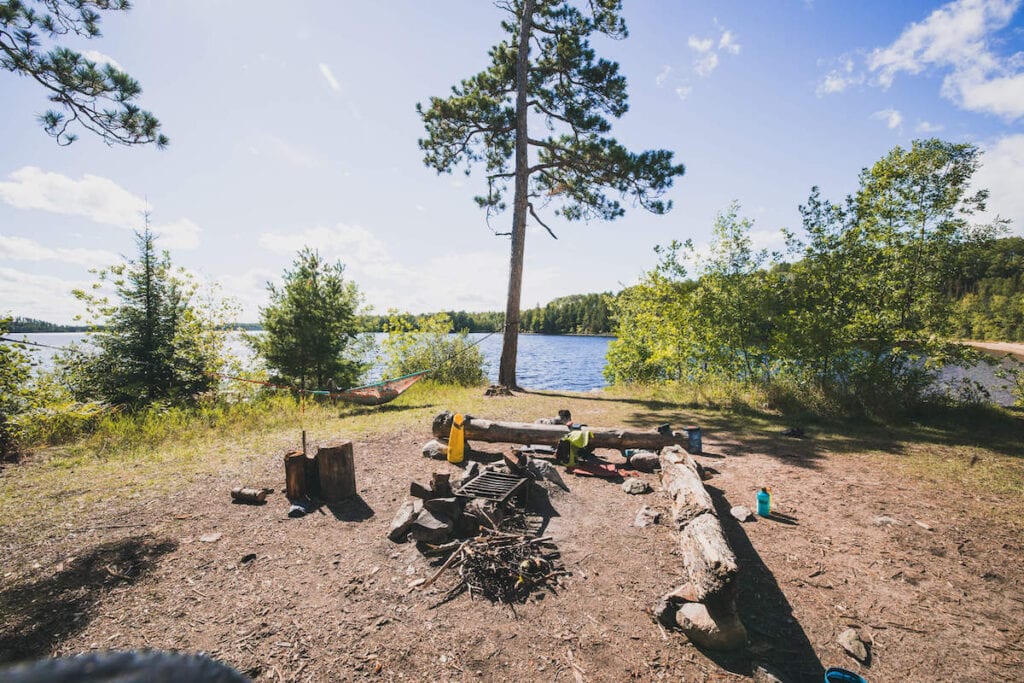
Boundary Waters Canoe Trip Gear
One of the best parts about canoe camping is that you only have to lug your gear on portages.
You can read our 3-day backpacking checklist to get a general idea of what you’ll need. It goes without saying that the Boundary Waters is a remote area; be sure to pack warm clothing and rain gear so you can stay safe in the event of storms, submerged and wet packs, or days or rainy weather.
Shoes for the BWCA
You’ll want good footwear for the Boundary Waters that can deal with water and rugged portages. I recommend water sandals whenever you’re in the canoe or getting in and out. Check our review of the Teva Universal Trail Sandal . These would be a great choice for a BWCA trip.
For portages, you’ll want hiking shoes or boots that have a closed-toe and closed-heel. These will keep your feet and ankles protected while carrying heavy packs and the canoe. Portages in the BWCA are filled with rocks, tree roots, and slippery mud so plan accordingly.
Dry Bags and Canoe Packs
While you can technically use a backpacking pack to carry your gear, using canoe packs from Duluth Pack, Frost River, or Granite Gear has its perks — it’s also what you’ll get from your outfitter if you rent a canoe. You can also invest in a few lightweight dry bags to keep your items dry and separated, like these Sea to Summit Lightweight Dry Sacks .
For a cheaper option, simply line your pack with a garbage bag and arrange your gear inside.
Navigating the Boundary Waters
You’ll need a compass, map, and map case (outfitters will provide these) for a Boundary Waters canoe trip. Fisher Maps , McKenzie , and Voyageur make the best BWCA maps or National Geographic also makes a detailed BWCA Map Pack . There’s little to no cell service in the BWCA, so don’t rely on your phone for navigation and pack or rent a satellite communication device for safety.
To navigate the Boundary Waters, your best bet is to orient yourself using portages, campgrounds, and prominent features of the shoreline like points, islands, bays, etc. It’s normal — and a right of passage — to get pretty confused about exactly where you are since the lakes and islands can make it seem like a maze. Don’t worry, it’s rare for visitors to actually get lost!
Water Gear & Equipment
Aluminum canoes are heavier to carry on portages, but they’ve got one big benefit: they’re bombproof. No need to worry about scraping a rock in these! Kevlar canoes are more fragile and require extra effort when using them, but they’re much lighter to use while paddling and portaging.
You’ll also need a fair amount of gear for your canoe (outfitters will provide all of this): paddles, life jackets , duct tape, sponge and bailer, and cords to tie in your packs. If you’re planning to fish, bring a pole and tackle box. And don’t forget a swimsuit!
Essential Clothing for Paddling
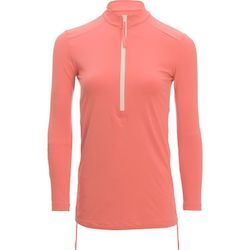
Carve Designs Cruz Rashguard
I prefer wearing a rashguard over sunscreen these days. I own the Cruz in 2 colors and it’s a staple for any water activity because it dries quickly but also keeps you cool, plus the cut is flattering.
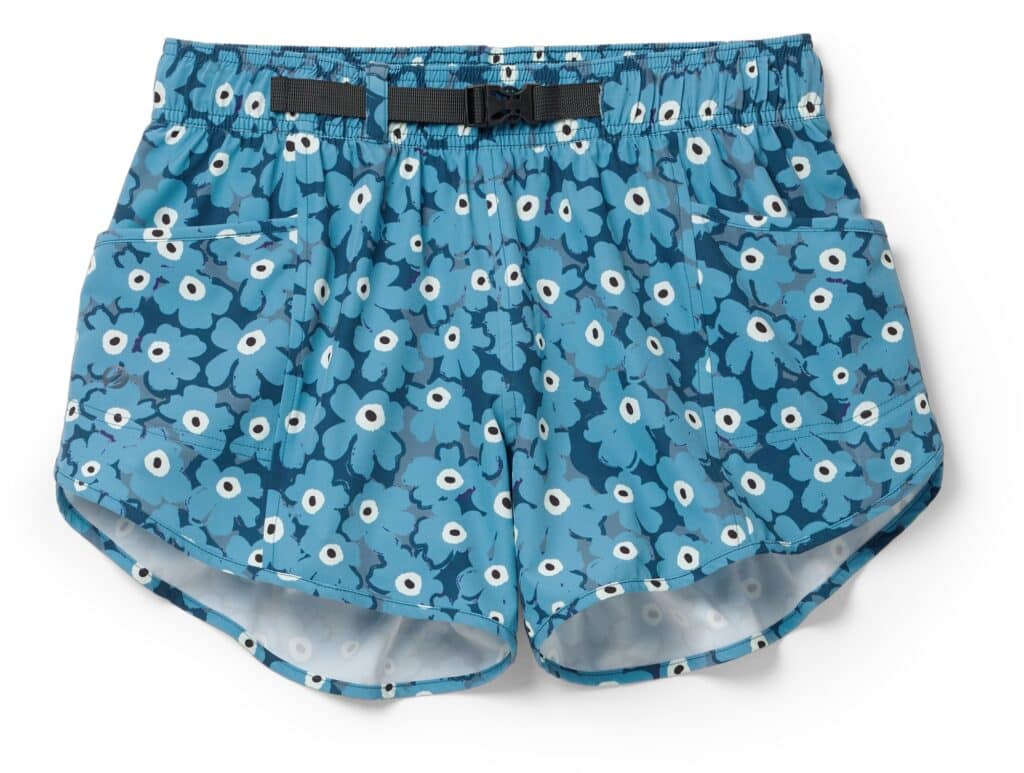
Nani Swimwear Hybrid Explorer Shorts
These shorts are super comfortable, dry really quickly, and come in a bunch of colors and prints. I wear them on all water adventures!

Teva Universal Trail Sandals
Sandals that stay on your feet and can get wet are essential. I like these because they have good grip and can be worn hiking as well, plus they can easily be strapped to your boat when not in use.

Outdoor Research Sunbriolet Hat
You’ll want a wide-brim hat that can get wet and has a chin strap so it stays on in the wind. This Outdoor Research hat is quick-drying, will float if it falls in the water, and comes in a variety of colors.
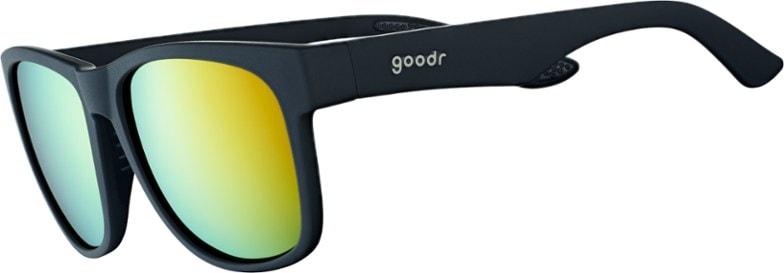
Goodr Polarized Sunglasses
Polarized glasses are best for the reflection of the water. I like to wear budget-friendly sunglasses paddling and I always wear a retainer so I don’t lose them in the water.
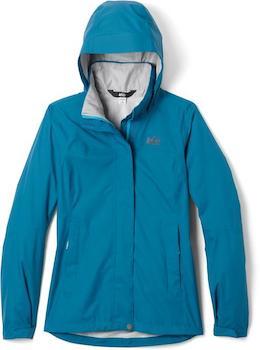
REI Co-op Rainier Rain Jacket
If it’s chilly or windy it can be helpful to have a lightweight rain jacket or windbreaker out on the water with you. I usually pack a jacket like this just in case!
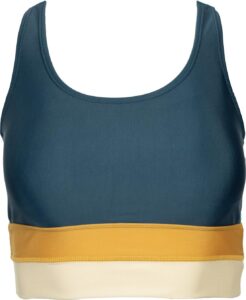
Supportive Swimsuit or Sports Bra
You’ll want a comfortable swimsuit that you can be active in. I like to avoid swimsuits that pull on my neck (like halters) and have been loving Nani Swimwear lately.
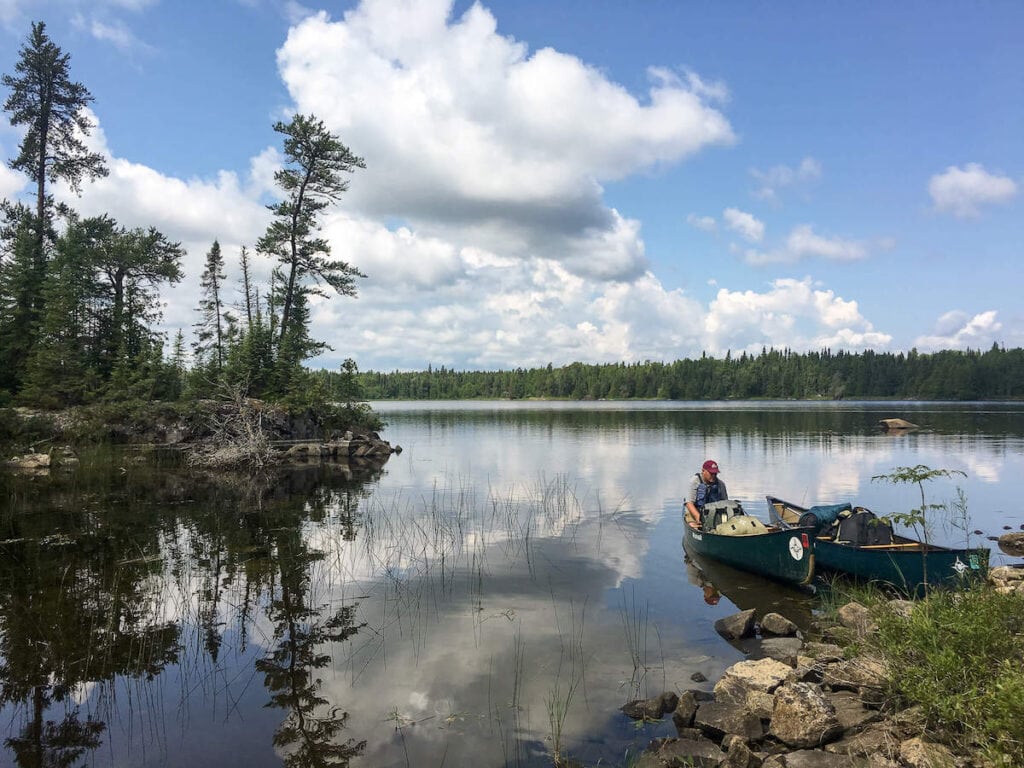
There are bears that live in the BWCA, but they rarely bother people. Most visitors opt to hang their food from a tree instead of bringing a bear canister. To hang your food bag, find a tree limb about 15-20 feet off the ground. Attach a heavy item to the end of your rope and throw it over the branch so that the rope is 4 feet away from the trunk. Now attach your bear sack to the rope, pulley your bag into the air, and tie off your rope. With a little searching, you can usually find a popular tree limb that’s used near each campground.
Water Filtration
Luckily, obtaining water in the Boundary Waters is much easier than most backpacking trips. While old-timers may still drink straight from the lake, it’s safer if you boil or filter the water. Simply paddle out away from your campsite and fill your containers from the lake, then purify or boil the water before using. While I used to drink straight from the lake, it’s not worth risking a Giardia infection.
The Platypus GravityWorks filter system is simple to use without needing to pump it. I’ve also used a Katadyn Hiker Microfilter in the BWCA, too, which I like because you can filter water straight into your water bottle while you’re canoeing.
I recommend filling and treating a 1- to 3-gallon water container when you arrive at your campsite to use for dinner, breakfast, and filling smaller 1-liter Nalgenes for the next day’s paddle.
Fire, Camp Stoves, and Cooking Gear
BWCA campgrounds have a fire pit area that can be used for cooking as long as there isn’t a fire ban in the area. The fires must be small and be put out completely when you’re not in camp. Firewood is available from the surrounding forest, but remember to only take dead and downed wood — live wood doesn’t burn well, anyway. If there is a fire ban, bring a camp stove for your cooking.
Sun Protection
It’s easy to get sunburned on a Boundary Waters canoe trip. Not only are you spending a lot of time out under the sun, but it’s also reflecting upward from your canoe and the water, too! Use sunscreen , a sun hat , and consider UPF clothing to keep the sun at bay.
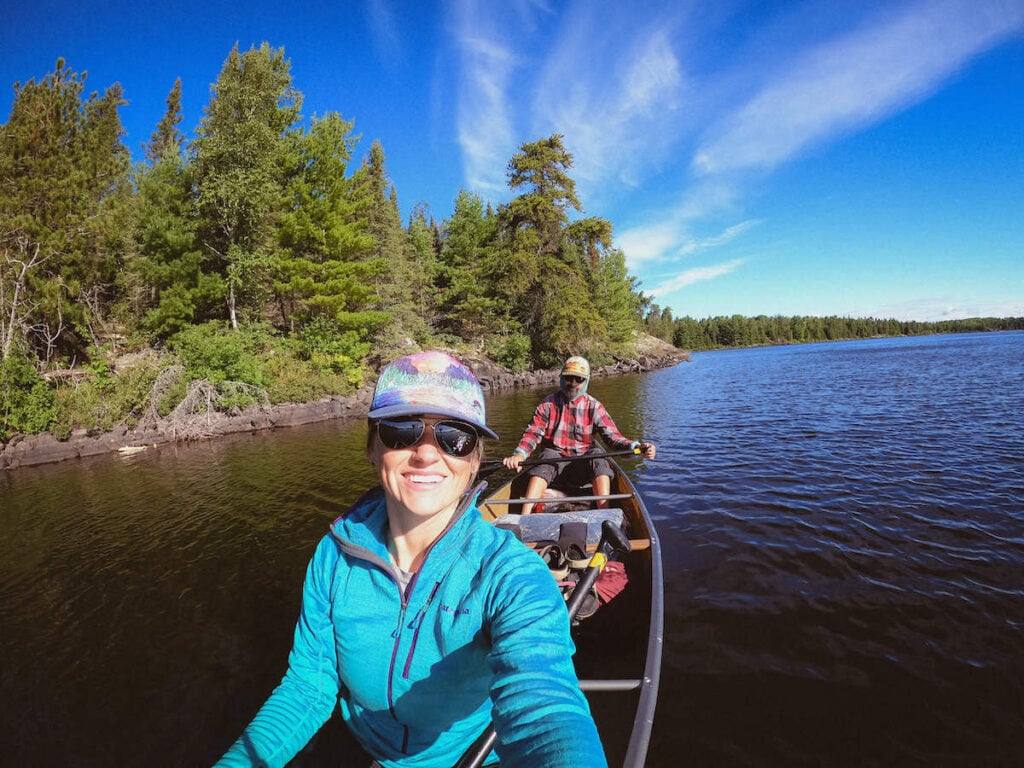
Help Protect the Boundary Waters
The BWCA is a unique, special place. But that doesn’t mean it always will be. Consider supporting the Friends of the Boundary Waters Wilderness to ensure this national treasure stays protected. Proposed copper-sulfide mines like Twin Metals risk contaminating and permanently polluting the Boundary Waters.
Learn more about threats to the BWCA and how you can help protect it by supporting Friends of the Boundary Waters Wilderness .
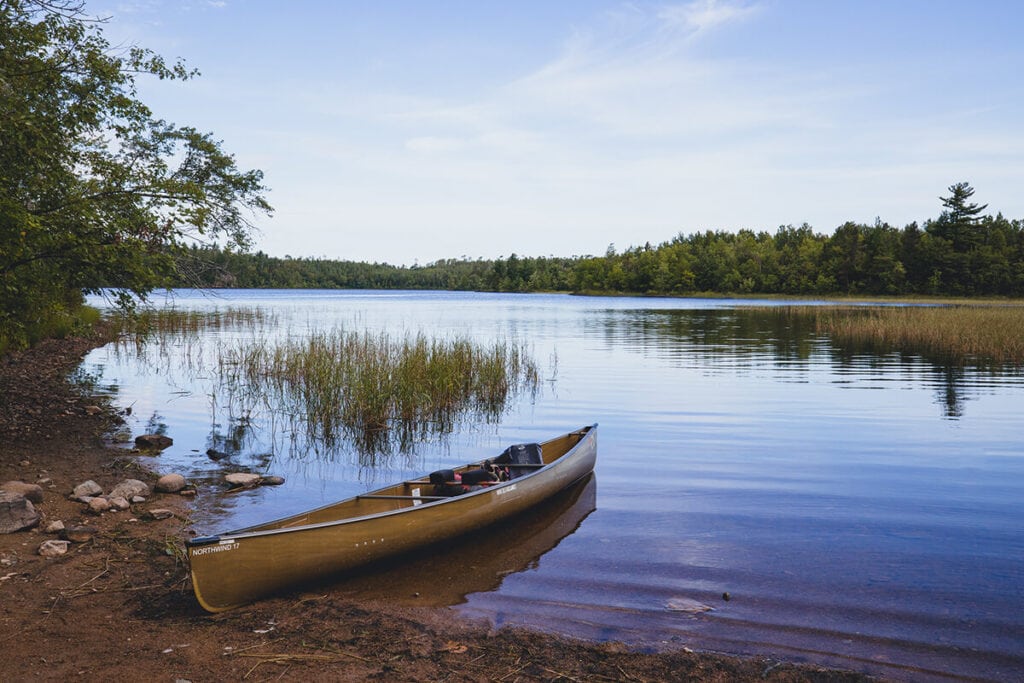
Taking a canoe trip through Minnesota’s Boundary Waters is a trip unlike any other, and thanks to its massive size and undeveloped character, it’s a wilderness you can return to again and again for new adventures. Whether you’re a seasoned paddler or new to canoe camping, the BWCA will not disappoint!
Have you done a Boundary Waters canoe trip or are you planning one? What questions do you still have? Let us know in the comments!
Related Posts
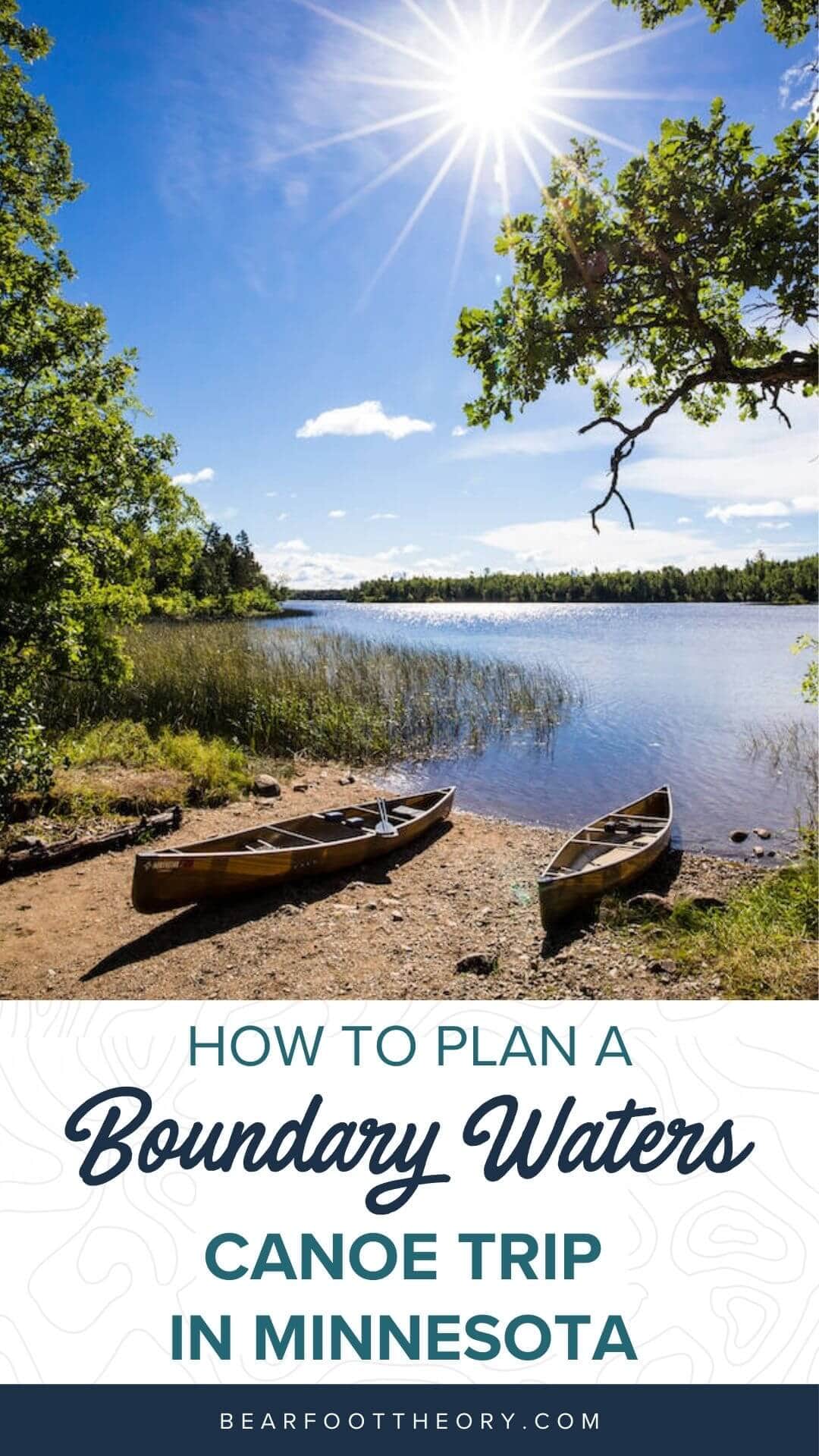
Isak is an outdoor freelance writer that loves traveling through Western public lands in his self-converted van to hike, ski, and find the country’s best used bookstores and coffee shops. When he’s not writing or adventuring, Isak is working on Seek More Wilderness to provide outdoor goods that give back to the outdoors. You can view his writing clips at IsakKvam.com and follow his van adventures on Instagram.
Leave a Reply Cancel reply
Your email address will not be published. Required fields are marked *
Save my name, email, and website in this browser for the next time I comment.
I just got back from the Boundary Waters (6 days, 5 nights in early-mid Sept) and it was amazing. I’m definitely making a trip back sometime, even though I had moments of questioning if i signed up for type 2 fun…. 1) drizzle to rain to soaked tent on night #2, 2) deluge welcomed us to a steep, rocky, slippery campsite, 3) trying to carry a canoe (even part way) on a mile long, level 8.5 portage (and then to find out that was only the second portage of a 3x portage day)…. but then we rewarded with the most beautiful rainbows, silence, starry nights, and disconnection from civilization. Great write up!
That sounds like an adventure!
Amazing clicks of pictures! we have done with same place and its look like a heaven on the earth and we enjoyed our trip. Before visiting this place, we consult with Boundary Waters Catalog about the place and we bought some tools from them. We got some information from some blogs and our trip was amazing.
Hi Eric, thanks for reading & the tip for the Boundary Waters Catalog. Glad you had an awesome trip!
Call us: 218-365-5581
Boy Scout High Adventure Canoe Trips for 2024
High adventure canoe trips for 2024, experience the boundary waters on your own terms.

Now is the time to plan your 2024 High Adventure Canoe Trips to the Boundary Waters. Our High Adventure Canoe Trips allow you to experience wilderness based your group’s goals. Making that happen is our primary function. We don’t dictate routes, pace, menus, or the number of people per canoe. Whatever your crew is coming to do, we will work with you to plan your route through the wilderness.
All High Adventure canoe trips are centered on your interests. Your itinerary is set by your ability level. Your route and pace is designed individually around you specific needs.
High Adventure Boundary Waters canoe trips offer a true wilderness experience. There are no roads through this area. Aircraft and motorboats are heavily restricted.
Our High Adventure Boundary Waters trips are 5 to 14 day wilderness canoe camping experiences. Typical treks cover 25 to 100 miles. You will travel through the Boundary Waters Canoe Area in Minnesota or Ontario’s Quetico Park . Our High Adventure Expedition Specials may be set-up to include both areas. All of our High Adventure trips start with private overnight lakeside accommodations at our lakeside canoe base. You may start and/or return directly from our docks. Other trips may start with van or boat transportation.
We are just six miles from Ely, Minnesota.
Nationally know anchorman Bill Kurtis narrates this 25 minute introduction to the Boundary Waters & Quetico Park, and North Country Canoe Outfitters

Our High Adventure Canoe Trips
All of our outfitting services are designed to give Boy Scout troops flexibility. YOUR High Adventure Boundary Waters crew:
- Sets the requirements for your participants to attend
- Determines the number of participants (starting with eight)
- Picks the number of days on the water (starting with five)
- Picks the arrival day of the week
- Picks whether to stay overnight before or after at our lake side base
- Picks the starting entry point location
- Picks the pace of the trip
- Picks the goals of the trip
- Picks the number of layover days on the trip (Of course we give our best advice for your needs on all of these)
Participants
The success of any high adventure program is more about the people you go with than the place you go .
A perfect trek may have crystal blue skies, comfortable temperatures, and no bugs. But it becomes a slow death march with a poorly prepared, poorly led crew. Likewise a few days hiking in the rain with a sharp crew leads to lifelong golden memories.
A High Adventure canoe trip should take your crew to a new level in the outdoors. It should develop the aims of Scouting:
- Growth in confidence,
- The opportunity to both lead and follow, and
- An appreciation for each crew member’s contribution to the group’s efforts.
Good equipment, good food, good surroundings, and good weather are all part of the picture. The biggest part is the challenge and satisfaction of accomplishing the goals of your high adventure canoe trip program. Setting these goals, knowing their importance, and preparing to meet them is the most important aspect of the trip. North Country can help with all of these.
2024 High Adventure Canoe Trip Packages
Our traditional Boy Scout canoe trip outfitting is complete. We use the same gear we offer to our private party customers.
First, what we DON’T do for a High Adventure canoe trip:
- require groups to bring their own sleeping bags, pads, utensils, cups and bowls
- insist jungle boots to be purchased
- make group buy extra copies of maps to be purchased at $50 to $90 per crew
- limit our supplied personal packs to one per three participants
- send nine people out in only three canoes
- we don’t use 72-pound aluminum canoes
Now, how WE do a High Adventure canoe trip instead:
- your clothing
- hygiene and grooming items
- fishing rods with basic tackle and lures
- group compass and first aid kit
- Foot ware should be rugged with closed toe and heal. They should drain easily.
- One set of maps, may be purchased ($16 to $32) as we plan your route with you, or bring your own
- Though we encourage two person’s personal items per pack, you may have as many as you need.
- The only time we recommend a 3-person canoe is for an odd number group size
- Our featured offering is a 2-person Royalex canoe (50-pound class): quiet for fishing, lighter for portaging. Our 64-pound aluminum canoes carry a $5/person/day discount: for the true novice, this canoe has the most stability on the market (short of some sort of outrigger set-up)
- We offer the most top quality group menu in the Boundary Waters featuring the 1st night out having a choice of Certified Angus Beef ® steaks or a pair of 1/3 pound Angus burgers.
- Most groups opt to spend the night before their trip in our lakeside bunkrooms (included) versus a motel in town.
High Adventure Canoe Trip Expedition Specials
Back in 2016 we introduced a new concept in Boy Scout High Adventures. Our Expedition Specials are keyed to the type of Boy Scout canoe trip your crew wants to experience. These High Adventure canoe trips are each set for a fixed number of days. All five canoe trips are outfitted, supplied, and priced for eight person crews. They are designed to start on specific days of the week. Should you need to change to another weekday, deductions are offered, or supplements are needed.
All of our Expedition Specials include:
- All gear and menu offerings listed in our Leader’s Guide
- Four “Two-to-a-canoe” Royalex canoes for your crew
- Staff briefing on equipment use, menu review, portaging skills
- Private overnight bunkrooms at our lakeside base before & after
- Fast start, full, hot, continental breakfast at our base on morning #1
- Van transportation to starting points, and from exit points
- Use of our campfire ring for your closing fellowship
- Boundary Waters patch for each participant
WILDERNESS 50 – MILER EXPEDITION SPECIAL
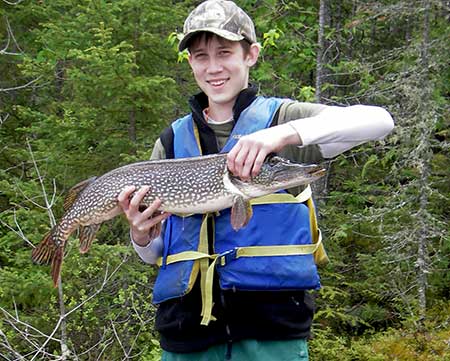
Imagine your “fish’in buddy” landing a trophy fish
In doing research for this Expedition Special, we found there are a lot of differing opinions about what the Boy Scout 50-Miler Program is all about. Most agreed it should be hard ; but that doesn’t mean brutal . In the north country, a 50-miler trip in 5 days requires a pace beyond what many Scouts and Scouters are capable of doing. An hour or two is needed each day to take down camp in the morning. Add another hour or two to set it up at the end of the day. Time is needed for meal preparation and clean-up. Then add in two hours per day for the 10 hour service project. The result is paddlers trying to cover 10-12 miles, with portages, in four to five hours day after day.
This trip is ideal for a Saturday afternoon arrival. Your 7-day High adventure Canoe Trip Expedition Special runs from Sunday to Saturday. Your last evening’s bunkroom is included, with departing for home on Sunday morning.
8 Participants All Inclusive Price: $6000 Bottom Line with tax exemption certificate. If arriving on Tuesday, Wednesday, or Thursday afternoon, deduct $400 per crew of 8.
Canoe Camping
Youth groups, bwca fishing, ncco: your outfitter, about the bwca.
Boundary Waters Canoe Area Wilderness Guide
The Boundary Waters Canoe Area Wilderness (BWCAW) covers 1 million acres with over 1,100 lakes, along the Minnesota-Canada border. Since 1978 and the passage of the BWCA Wilderness Act, these lands have been designated “an area where the earth and its community of life are untrammeled by man, where man himself is a visitor who does not remain.” With 200,000 visitors a year the BWCAW is the most popular wilderness area in the country! There are 59 paddling entry points between Cook , Ely , Tofte, Isabella , and Grand Marais to begin your canoeing adventures. Check out our popular interactive BWCAW Entry Point Map and scroll down for Park Information.
Explore Canoe Trip Services:
• Ely • Grand Marais • Tofte and Isabella • Orr/Crane Lake • Cook
Park & Permit Info
Entry point reservations and rules & regulations:.
BWCAW Trip Planning Guide [pdf]
BWCAW Online Reservations/Permits
The BWCAW rules and regulations are designed to retain the area’s “wilderness character,” as stated in the 1978 BWCA Wilderness Act. The park is managed by the United States Forest Service as part of the Superior National Forest, whose headquarters are in Duluth with ranger stations in towns across northeastern Minnesota. Motorized watercraft are prohibited except for day-use on a few large lakes around the park’s boundaries. Camping is only allowed at designated sites that have a pit-toilet and a fire grate. To reduce visitors’ environmental footprint they are asked to uphold the Leave No Trace guidelines and groups are capped at 9 people and 4 watercraft.
Human impact in the BWCAW is also moderated by requiring visitors to have a permit. There are several permit varieties depending on what time of year you go and what sort of trip you take: From May 1 to September 30, all overnight stays and motorized day-use require quota permits, but self-issued permits are available for non-motorized day-use. From October 1 to April 30, all permits are self-issued for either day or overnight use. Quota permits should be reserved ahead of time, and then picked up at Forest Service stations or a cooperating organization, such as an outfitter. Self-issued permits do not require any reservation and can be obtained at Forest Service stations, some BWCAW trailheads, and through the mail.
Another result of the permit system is that visitors are encouraged to travel to new places within the wilderness area. Reservations require forethought and invite canoeists to look at entry points all across the map.
The Friends’ Guide to the Boundary Waters
www.recreation.gov
Leave No Trace Superior National Forest
Fire Information
The use of campfires in the BWCAW is more controlled than in other popular canoeing areas due to the massive blow down of trees in the forest that occurred on July 4, 1999. Since that event, the U.S. Forest Service, which manages the wilderness, has attempted to moderate wildfire risk with controlled burning. Recent wildfires have also reduced the fuel load.
Paddlers in the BWCAW are advised to keep abreast of wildfire conditions via the USFS BWCAW web site . Paddlers can plan trips using this USFS map which outlines restricted and unrestricted fire areas in the wilderness. As always, visitors are encouraged to use gas or propane cook stoves to reduce impacts to the wilderness.
MN DNR: Current Fire Restrictions
Maps & Routes
The most commonly used maps for paddling in the BWCAW are those produced by W. A. Fisher Maps and Publications and McKenzie Maps. The maps mark and measure portages, denote campsites, and include topographical contours. The U.S. Forest Service produces a map of the entire Superior National Forest that, while impractical for trip navigation, can help in selecting entry points and planning trips.
The network of lakes, rivers, and portages in the BWCAW creates an infinite combination of routes. Adventurous paddlers can pick an entry point and travel routes to match the time and energy they have to spend. Some basic routes, each launching from the region of a different permit-granting ranger station, are listed below.
Popular Boundary Waters Canoe Routes:
Seagull Lake – Alpine Lake – Red Rock Lake – Saganaga Lake – Seagull River – Gull Lake 1-2 Days, Easy to Moderate Explore the effects of fire on the Boundary Waters on this canoe route. Read More >
Rose Lake Weekender (Gunflint Ranger Station) 2-4 Days, Easy Paddlers short on time or in the mood for a quick, easy trip should consider picturesque Rose Lake. From the launch on Bearskin Lake, it’s just two portages to this lovely border lake. A base-camp on Rose is nicely positioned for a day-trip to the Height of Land Portage between North and South Lakes–the drainage divide between waters flowing to Lake Superior and the Atlantic Ocean and those going north to Hudson Bay. In the voyageur era, travelers who crossed this portage heading north earned the title “Men of the North” and the honored status that went with it.
Sawbill–Long Island–Winchell Lake Loop (Tofte Ranger Station) 6 Days, Difficult With a week to commit to canoe and paddle, trippers can circle a large swath of the eastern BWCA with this route. Heading north from the Sawbill Lake entry point, venture out through Cherokee Lake toward Long Island Lake. From there, you can follow either of two routes to lovely Winchell Lake. From Winchell, head south to massive Brule Lake, but plan extra time in case the winds are unfavorable. From Brule, head back to Sawbill via Knife and Jack, Burnt and Smoke Lakes. The trip includes big lakes and sinuous creeks. There are some long portages and you’ll be covering a lot of ground, but if you’re ready for the trip you’ll be well rewarded.
The Sawbill Lake Outfitters website describes in detail eleven trips to do in the area.
Bald Eagle–Kawishiwi River–Lake Three (Isabella Ranger Station) 4-6 Days, Moderate From your entry point at Snake Creek which flows into Bald Eagle Lake, you can loop to the northwest via Gabbro Lake and the Kawishiwi River. From the “Kawish,” you can work your way east through the “Number Lakes”–Lake One, Lake Two, and Lake Three. You can extend your trip through, yep, Lake Four toward, nope, Lake Insula, but you’ll need to backtrack to return. (A base-camp on Lake Four, however, offers two nice day-tripping loops to the north and south.) To get back home, portage to Rock of Ages Lake from Lake Two and then from Clearwater Lake return to your entry point via Pietro and Gull Lakes.
Mudro–Fourtown–Basswood River–Crooked–Angleworm (Kawishiwi Ranger Station, Ely) 6 Day, Difficult This classic BWCAW trip features pictographs, waterfalls, and time spent paddling along the international border. Start at Mudro Lake (but leave a second vehicle at nearby Hegman Lake) and paddle through Fourtown and Horse Lakes and down the Horse River to Lower Basswood Falls. After enjoying and portaging the falls, admire the pictographs downstream made famous in the Francis Lee Jacques painting. (Or camp within evening paddling distance of Wheelbarrow and Upper Basswood Falls.) From there, follow the river to Crooked Lake. If you want to see one more waterfall, paddle beyond Friday Bay on a day-trip to admire Curtain Falls at the outlet of Crooked Lake. Otherwise, portage out of the lake at the bottom of Friday Bay toward Angleworm Lake. From Angleworm there’s a 460-rod portage to get home, but you should be fit and your food pack light by now. At Hegman Lake, you’ll be rewarded for your efforts by the lake’s famous set of pictographs.
Moose River–Lake Agnes–Lac la Croix (LaCroix Ranger Station, Cook) 6 Days, Moderate Here’s another BWCAW classic: Follow the Moose River north to Nina Moose Lake and Lake Agnes. Then follow the Boulder River North into Lac la Croix. (As an alternative, you can take the less traveled Stuart River–and its 480-rod portage–to reach Stuart Lake, and then follow the lovely Dahlgren River to Lac la Croix.) On Lac la Croix you’ll find two of the landmarks of Quetico Superior country–the Lac la Croix pictographs and Warrior Hill. Off Iron Lake to the east you can enjoy Rebecca and Curtain Falls. You can lengthen the trip and avoid back-tracking by paddling west through Lac la Croix’s Fish Stake Narrows to Pocket Creek and then returning south through Ge-be-on-e-quet, Green, Rocky, and Oyster Lakes back to Agnes.
W. A. Fisher Maps
McKenzie Maps
Voyageur Maps
BWCAW Maps at ShopCanoeing.com
The BWCAW as we know it today was born with the Boundary Waters Canoe Area Wilderness Act of 1978. But a long, often contentious, history brought events to that point. The Shipstead-Newton-Nolan Act of 1930, the first federal law to order the setting aside of lands for wilderness, effectively ended Edward Backus’ plans to impound waters in the area for industrial hydropower. The Wilderness Act of 1964 established the current wilderness preservation system in the country. The next year, a new management plan for the Boundary Waters required permits to enter the wilderness. In 1971 designated campsites were instituted on heavily used lakes. In 1975 designated campsites were made a wilderness-wide rule and allowable group sizes were lowered from 15 to 10 persons. Despite Representative James Oberstar’s bill to establish a Boundary Waters Wilderness Area of 625,000 acres and a Boundary Waters National Recreation Area of 527,000 acres where logging and mechanized travel would be allowed–including on Lac la Croix, Basswood, Saganaga, and Seagull Lakes–the Boundary Waters Act was passed in 1978. Since then, wilderness and multiple use proponents have often used the courts to clash over interpretations of the Act.
History of the Quetico Superior Region
Superior National Forest
Like Quetico Provinicial Park to the north, evidence of the last glaciation in the area sets the stage for the natural world of the BWCAW. The exposed Pre-Cambrian bedrock–smoothed, rounded, scratched, and cracked by the ice–provides the foundation for the wild plant and animal life of the wilderness, where wolves follow moose beneath towering pines.
The BWCAW forest–at the transition zone between mixed hardwoods of the Lake Superior region and the confers of the farther north–is composed of coniferous species like the white, red, and jack pine, the black spruce and deciduous trees like aspen and birch.
Large mammals living in the forest include the moose, white-tailed deer, and their prime predator, the timber wolf. The omnivorous black bear haunts the landscape and a campsite or two. Beavers paddle the ponds. Small mammals include the snowshoe hare, the eastern chipmunk and the red squirrel.
The area boasts 250 species of birds from the soaring eagles and ospreys to flitting warblers and flycatchers. The hoot of the Barred Owl and the call of the Common Loon provide the background music for the landscape.
Friends of the Boundary Waters Wilderness
The BWCAW is known for its wide variety of fishing opportunities. In the deeper lakes, many of them in the northeast of the wilderness, lake trout are the most sought-after species. Lake trout, found in deep water once the weather and lake temperatures warm, can be found in shallow water in the spring and early fall.
Northern and walleye pike are present in most of the lake of the region, with the latter providing the main course of many a BWCAW shore-lunch. Northern pike are the easiest to catch as this major predator is one to strike first and ask questions later when it comes to your lure. In selected lakes, anglers can find small-mouthed bass. Small-mouth fishing is best in the late-spring and early summer.
Minnesota DNR: Fishing
Remote Border Crossing
The BWCAW and Quetico Provincial Park meet along the border between Canada and the United States. Canoeists can paddle across the border, but while the wilderness is contiguous, park management and government regulations are not. Understanding the rules ahead of time will ease your remote border crossing process.
Entering the United States
Whether you drive or paddle into the U.S. you must have the proper government-issued identifcation on hand.
U.S. citizens entering the U.S. at sea and land ports of entry must have a passport, passport card, or compliant document. Canadian citizens must present a valid passport or other approved document. For more information visit U.S. Travel.State.Gov
Paddling Into the BWCAW from Canada
If your canoe trip starts in Canada and you paddle into the BWCAW from Quetico or the Crown Lands, you must apply for BWCAW permit entry #71. You are also required to report to a U.S. Customs Border Protection officer for inspection at the end of your trip. You can report to inspection locations in Grand Portage, Grand Marais, Crane Lake and Ely. To learn more, call Customs directly at 218-475-2244.
Canoe trips that originate in the BWCA, pass into Canada and then return to the BWCAW do not require Permit #71. Re-entry into the BWCAW is covered by the permit for their original point of entry.
Paddling Into Quetico from the U.S.
Different regulations apply for paddling across the international border into Quetico Provincial Park. Learn More >
CANPASS Remote Area Border Crossing (RABC)
U.S. Travel.State.Gov
U.S. Customs and Border Control
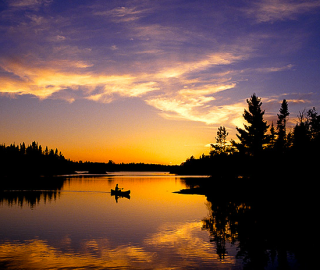
Boundary Waters Canoe Area Wilderness (BWCAW) Guide
Bwcaw jump-off points:.
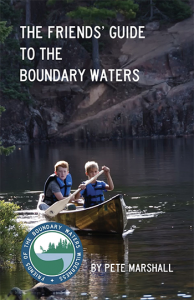
Video Trip Log: BWCA 4 Day Trip

BWCA Fall 2020 Moose Lake Loop ”Intense Paddle“

The Saga Continues

First Overnight in the BWCA

Boundary Waters Canoe Area Wilderness: Modified Kawisihiwi Lake/Lady Loop

• Disclaimer and Use Policy
https://tigaprediksi.com/
https://armynavysuperstores.com/
https://dutawarta.com/
https://woaynews.com/
https://pupwb.org/
https://haraznews.com/
https://toysmatrix.com/wp-includes/slot-gacor/
https://girimenangnews.com/
https://geprekbensuindonesia.com/
https://everythinginclick.com/wp-content/uploads/slot-bonus/
https://caraslot.com/wp-includes/slot-bonus/
https://www.casablancahire.com/blogs/wp-includes/slot-bonus/
https://www.genesiscalbeautystudio.com/wp-includes/slot-bonus /
https://www.hookdonthehudson.com/
https://bimbelruangprestasi.com/wp-includes/slot-bonus/
https://thenews100.com/
https://expertautokool.ee/wp-includes/slot-bonus/
https://www.padslakecounty.org/wp-content/uploads/rekomendasi-situs-slot-gacor-gampang-menang/

Compare items
- Total ( 0 )
OutdoorSkillz
Paddle and Camp Happy By Being Prepared

Ultimate Guide on How to Plan a Boundary Waters Canoe Trip – 10 Tips, Tricks, and Expert Advice
The Boundary Waters Canoe Area (BWCA) is a breathtaking expanse of interconnected lakes and rivers nestled within the Superior National Forest in northeastern Minnesota. Its pristine wilderness, abundant wildlife, and unparalleled tranquility make it a must-visit destination for paddling enthusiasts and nature lovers. To ensure your adventure is memorable and safe, follow our comprehensive step-by-step guide on how to plan a Boundary Waters canoe trip, covering everything from permits and entry points to safety precautions and Leave No Trace principles.
Plan A Boundary Waters Canoe Trip
Navigating the wilderness: 10 essential steps for planning your boundary waters canoe adventure.

The Boundary Waters Canoe Area offers a unique opportunity to immerse yourself in pristine nature. To fully enjoy this wilderness experience, proper planning is crucial. Follow these 10 essential steps to prepare for your canoe adventure, ensuring a safe and memorable trip through the BWCA’s breathtaking landscapes.
Step 1: Choose Your Dates
Determining the time of year and duration of your trip is essential. The peak season for the BWCA is between June and August , offering warmer weather and longer daylight hours. However, spring and fall visits provide a more peaceful experience with fewer visitors, cooler temperatures, and, in some cases, striking fall foliage.
Step 2: Research Permit Requirements
A permit is required for all overnight trips in the BWCA between May 1 and September 30. Obtain your permit through Recreation.gov, where you’ll find information on permit quotas and regulations. In addition, day-use motor permits are needed for some areas, so research those requirements if applicable.
Step 3: Select an Entry Point

With over 60 entry points in the BWCA, choosing the right one is crucial. First, research and select an entry point that matches your skill level, desired trip length, and interests. Popular entry points include Seagull Lake, Sawbill Lake, and Lake One. Each entry point offers access to different routes, so consider how these routes align with your adventure goals.
Step 4: Plan Your Route
Based on your chosen entry point, research and plan a route that suits your group’s abilities and interests. Consider factors like distance, portage difficulty, and the number of campsites along the way. Then, utilize online resources, guidebooks, and maps to help you plan a route that will provide an enjoyable and safe experience.
Step 5: Reserve Your Permit
Once you have selected an entry point and planned your route, reserve your permit through Recreation.gov. Booking early is essential, as permits can fill up quickly, especially for popular entry points and dates.
How do you get a permit for a trip to the BWCA

To obtain a permit for a trip into the Boundary Waters Canoe Area (BWCA), follow these steps:
- Visit the reservation system at Recreation.gov: Go to the Recreation.gov website ( https://www.recreation.gov/ ) and search for “Boundary Waters Canoe Area Wilderness” or directly visit the BWCA permit page ( https://www.recreation.gov/permits/233396 ).
- Choose your entry point and date: Permits are specific to entry points and dates, so you’ll need to select the desired entry point and the date you plan to enter the BWCA. Research entry points and plan your route before making a reservation.
- Create an account or log in: If you don’t already have one on Recreation.gov, you’ll need to create one. If you already have an account, log in to proceed with the reservation.
- Complete the reservation: Fill out the required information, including your group size and other details. Review your reservation and pay the applicable fees. Reservation fees and overnight camping fees will apply.
- Print your permit: After completing the reservation and payment, you’ll receive an email confirmation. You must pick up your permit in person at the designated permit-issue station on the entry date or the day before. Before receiving your permit, you must watch the Leave No Trace video and review the BWCA regulations with a Forest Service staff member.
Remember that permits for overnight trips in the BWCA are required between May 1 and September 30. They are issued on a first-come, first-served basis, so it’s best to reserve your permit as early as possible, especially for popular entry points and dates.
Step 6: Organize Your Gear

Compile a comprehensive list of the necessary gear, such as camping equipment, clothing, cooking supplies, and navigation tools. Then, inspect your gear for needed repairs or replacements, and make sure you have appropriate items for your trip, including a bear-resistant food container.
Step 7: Plan Your Meals
Create a meal plan for your trip, considering the number of days and your group’s preferences. Opt for lightweight, non-perishable, and easy-to-prepare foods. Consider pre-portioning meals in resealable bags to save space and minimize waste.

Step 8: Practice Leave No Trace Principles

Familiarize yourself and your group with Leave No Trace principles to minimize your impact on the wilderness. These principles include packing out all trash, using established campsites and fire grates, and properly storing food to avoid attracting wildlife.
Step 9: Monitor Weather, Water, and Fire Conditions
Before your trip, keep an eye on the weather forecast, water levels for your chosen route, and fire conditions in the BWCA. Visit the Superior National Forest website or contact a local ranger station for the latest fire danger ratings and potential fire restrictions. Then, adjust your plans if necessary to account for any potentially hazardous conditions.
Step 10: Review Safety Procedures

Ensure everyone in your group is familiar with basic wilderness safety procedures, such as using a map and compass, handling a canoe in windy conditions, and knowing what to do in an emergency.
What to Do If You’re Injured in the BWCA
Injuries can happen, even with the best preparation. Knowing how to respond to an injury in the BWCA can significantly affect the outcome. Here are some steps to follow if someone in your group is injured:
Stay calm: Keep a clear head and assess the situation. Remaining calm will help you make better decisions and reassure the injured person.
Assess the injury : Determine the severity of the damage and whether it requires immediate attention or can be managed until you return to civilization.
Administer first aid: If you’re trained in wilderness first aid, provide appropriate care for the injury. Always carry a well-stocked first aid kit in your gear.
Adjust your plans: If the injury is severe and requires evacuation or professional medical attention, alter your route to reach the nearest exit point or ranger station as quickly and safely as possible.
Call for help: If necessary, use a satellite phone, personal locator beacon (PLB), or satellite messenger to request emergency assistance. Cell phone coverage in the BWCA is unreliable, so consider carrying a satellite communication device for emergencies.
Video: Plan A Boundary Waters Canoe Trip
Final Thoughts On How to Plan a Boundary Waters Canoe Trip

Embarking on a Boundary Waters Canoe Area adventure requires thorough planning and preparation, but the reward of experiencing this pristine wilderness is well worth the effort. By following our step-by-step guide, you’ll be well-equipped to navigate the challenges and marvel at the beauty of the BWCA, creating memories that will last a lifetime.
Michael Hardy
Michael is the founder of Thumbwind Publications and a freelance writer. His projects include; AITrueReview , which strives to improve the quality of articles and writing using AI tools, and FloridaMarkers which experiments in Programmatic SEO
You might also like

Camp & Explore The Flathead National Forest – A Nomadic Montana Experience

10 Must-Have Outdoor Photos To Stand Out On Your Next Wilderness Trip

7 Best Coastal Camping Spots in California
Leave a reply cancel reply.

- BEST AMERICAN ADVENTURES
Canoe the Boundary Waters, Minnesota
See trip details for canoeing the Boundary Waters in Minnesota, one of 100 best American adventure trips from National Geographic.
If you’re planning to rob a bank in the Midwest, arguably your best escape route is through the Boundary Waters Canoe Area. After entering this one-million-acre (400,000-hectare) bastion of lakes, streams, and primordial pine, birch, and aspen forests, you’re very unlikely to be found. That goes for law-abiding escapists, too. The Boundary Waters offer some 1,500 miles (2,414 kilometers) of canoe routes and 2,000 secluded campsites; in other words, it's the perfect territory in which to disappear for a while.
Plenty of people organize their own trips into the BWCA, but it’s far easier to let Ely, Minnesota-based Boundary Waters Outfitters do the work. They’ll organize meals, plan a route, rent equipment, and hand over all the maps. For true solitude, go in late August or early September when the summer crowds have thinned, or have the outfitters charter a float plane, which will drop you off far away from any signs of civilization.
Take at least four days to explore lake after lake, punctuated by rocky cliffs, waterfalls, and Native American pictographs. That’s about how long it takes to tune in to the heartbeat of this place—the silky water, the changeable skies, the deep fairy-tale-like forest, and all of the small details: moose and deer frequenting the shallows, eagles gliding between trees, and fresh wolf prints on shorelines.
Need to Know: Boundary Waters Outfitters ( www.boundarywatersoutfitters.com ) fully outfits trips and offers guides on a custom basis . Unguided, four-day trips start at $406 per person.
« Previous: Race the Arrowhead 135
Next: Hike the Superior Trail »
- Nat Geo Expeditions
LIMITED TIME OFFER
Receive up to 2 bonus issues, with any paid gift subscription!
Related Topics
- TRAVEL AND ADVENTURE
You May Also Like

Canada's greatest natural wonders, from icebergs to the world's highest tides

Bear Grylls reveals his top travel tips

How to plan the ultimate campervanning adventure through Australia

Six of the best adventures in New Zealand, from bouldering to bungy jumps

How to explore Argentina's wild Misiones province through the eyes of the Indigenous Guarani people
- History & Culture
- Photography
- Environment
- Paid Content
History & Culture
- Mind, Body, Wonder
- Terms of Use
- Privacy Policy
- Your US State Privacy Rights
- Children's Online Privacy Policy
- Interest-Based Ads
- About Nielsen Measurement
- Do Not Sell or Share My Personal Information
- Nat Geo Home
- Attend a Live Event
- Book a Trip
- Inspire Your Kids
- Shop Nat Geo
- Visit the D.C. Museum
- Learn About Our Impact
- Support Our Mission
- Advertise With Us
- Customer Service
- Renew Subscription
- Manage Your Subscription
- Work at Nat Geo
- Sign Up for Our Newsletters
- Contribute to Protect the Planet
Copyright © 1996-2015 National Geographic Society Copyright © 2015-2024 National Geographic Partners, LLC. All rights reserved
- Skip to content
- Skip to primary sidebar

Tanner's Trails
Long Term Adventure, Expeditions, Survival, Bushcraft And Self-Reliance
Boundary Waters Packing List: Ultimate Guide To Everything You Need
All Posts , Camping , Minnesota , Outdoors , Travel / Last Modified: September 6, 2023 by Tanner's Trails
Every year since 2020, I have embarked on a solo wilderness journey throughout the Boundary Waters Canoe Area Wilderness. During my research and trial process, I found exactly what gear is necessary on any multi-day canoe excursion up North, so with that said, here is my complete guide for a boundary waters packing list .
Before I begin, it is important to know how to stay safe while in the wild. So I want to share something.
Did you know that every year, people tragically pass away in the Boundary Waters wilderness due to drowning?
The reality is that more than 90% of these individuals weren’t wearing a life jacket . Wearing a life jacket while paddling isn’t just important – it can save your life! Don’t be another statistic – put on a PFD and paddle safely.
Now that that’s clear, lets begin the fun stuff!
Preview: In this article, you will be able to see EVERYTHING that I bring with me on my wilderness canoe trip. In the end, you will also be able to see some other useful canoeing information ranging from maps, safety tips, and more.
14: Portaging
Complete boundary waters packing list.
This gear list has been dialed down after many trips including a 30-day solo traverse of the entire wilderness area . I’ll put my recommendations as well as the reasoning behind the gear I brought!
1. Canoe Gear

Canoe Gear Checklist:
- Canoe (Kevlar Material For Easier Portaging)
- Sponge (For Small Puddles In Canoe)
- Paddle (I Ain’t Swimming
- Backup Paddle (Paddles Break Easily, Foldable Paddles Work As Backup)
My solo canoeing experience was completely transformed after I discovered the Wenonah Encounter 17ft solo canoe as it seemed to be the perfect vessel for the large open-water route that I took. It proved to be immensely steady, lightweight, and reliable enough that I had no qualms about trusting it on a month-long excursion.
If I were ever to do this again, I’d use exactly the same canoe; an old preloved one purchased from Boundary Waters Outfitters .
Choosing The Right Canoe
When looking for a canoe, it is important to consider the various available models and materials. Kevlar canoes are especially popular (95% of paddlers in the BWCA) among boaters in the BWCA, while aluminum canoes are also an option worth considering. Here are the benefits/downsides of each:
Kevlar Benefits: Kevlar canoes are favored by many boaters due to their lightweight yet durable design. They offer superior speed and maneuverability, making them ideal for those who want to explore the Boundary Waters with a sense of agility. Additionally, these boats are highly resistant to abrasion and corrosion. This makes them particularly suitable for Boundary Waters conditions.
Kevlar Downsides: Kevlar boats are usually expensive and require more maintenance than their aluminum counterparts. They may also be prone to punctures, so it’s important to inspect them regularly, as well as check for any potential leaks and carry a repair kit.
Aluminum Benefits: Aluminum canoes are known for their rugged construction and excellent durability. They are often less expensive than Kevlar canoes, require minimal maintenance, and can stand up to a significant amount of rough wear and tear. Additionally, they offer impressive maneuverability in Boundary Waters conditions, making them great for those who want to explore more remote areas.
Aluminum Downsides: Although they are relatively lightweight, aluminum canoes tend to be heavier than Kevlar boats. They may also require more effort when it comes to turning and maneuvering in tight areas.
One staple that should always be attached to your canoe- or any boat really- is a sponge. There were times when it would be drizzling when I’d be out paddling and the sponge, which was attached with a bungee cord, allowed me to prevent water from pooling in the bottom of the canoe.
Canoe Paddle And Backup
Choosing your canoe paddle can be a personal preference, but it is important to have a paddle that suits the Boundary Waters. Bending Branch offers a variety of high-quality paddles designed specifically for canoeing in Boundary Waters conditions.
The brand provides single-blade, double-blade, and bent-shaft designs that are all lightweight yet sturdy enough to handle any challenge you may encounter on the water.
It is always wise to keep a spare paddle with you while canoeing. Crafting a secondary paddle may be an option (good luck), but having one prepared in advance will make your life much easier. I attached my backup oar to the hooks located on my vessel using zip ties for added security and convenience.
Canoe Paddling Safety Tips
As I embarked on my canoeing excursions, I typically kept a rope connected from the front handle of my vessel to the back. This was an easy and effective way for me to guarantee that even if I flipped over in choppy waters, all of my bags would remain tethered firmly to the boat. A minor precaution like this can be invaluable!
Also, to add to the above, and to ensure maximum safety while paddling, it’s essential to attach a FLOATING rope from the back handle that trails in the water. This is especially important when out on wide-open lakes with strong winds – because if your canoe overturns, you don’t want it drifting away! While this may seem like only a small detail, it can be crucial for keeping yourself safe and sound.
2. Canoe Packs

Canoe Pack Checklist:
Canoe barrel (2x).
- Canoe Barrel Backpack
- Small Backpack
After much consideration, I selected two 60-liter canoe barrels for my wilderness trip. They are incredibly rugged and buoyant, as well being waterproof and easily tucked away in the canoe itself. Had it been a short trip, one would have sufficed; however since this was a journey of several weeks’ duration, I opted to store all my necessary items in one barrel while keeping food reserves in the other.
All that said – if you prefer them – traditional backpack options will work just fine too!
Everything in my boundary waters packing list would fit directly into two of the canoe barrels if I was doing a trip 2 weeks or shorter. Since I had 4 weeks total of food, I had an extra small pack listed below.
Canoe Barrel Pack
I needed a canoe barrel pack to be able to portage effectively, so I had no choice but to double-portage each time given that my pack could only carry one barrel at once. Fortunately, the quality and craftsmanship of this particular piece were truly remarkable – it exceeded my expectations in every way! I couldn’t be more pleased with its performance.
Smaller Pack
I opted for the Petzl Transport 45 Liter Backpack because of its convenient size. It did exactly what I needed, but any comparable-sized bag would have been just as great! Additionally, shorter trips would allow for different packing methods.
3. Sleep System

Sleep System Checklist:
Sleeping pad, sleeping bag, waterproof compression sack.
Foam pad. You can’t beat the durability and I personally sleep better on them. I like them because foam pads are incredibly durable and can withstand the rigors of any terrain, and they give you added versatility when it comes to packing items for Boundary Waters excursions because you can use them as a seat around camp.
Marmot Trestles 20 Degree Sleeping Bag: Perfect bag for paddling. The fill is synthetic and will still insulate when wet, yet the bag is still lightweight and packs down well enough. Synthetic insulation sleeping bags are a popular choice for Boundary Waters canoe trips due to the fact that they retain their warmth even when damp or wet. This makes them ideal for Boundary Waters Canoe Trips where you may tip a canoe!
To keep my sleeping bag and extras dry in the event of a spill, I opted for a 30-Liter Sea To Summit Compression Sack. This waterproof sack was more than enough to guarantee that my sleeping bag and clothes wouldn’t be left sopping wet!

Shelter Checklist:
I brought my favorite tent, the Nemo Dagger 2-Person tent. This includes the tent body, rainfly, stakes, poles, and guylines as well as 100 feet of paracord for tying out my tent during storms.
After using this tent for several years, I still find that I love it as much as I did when I purchased it. It is lightweight, durable, spacious, and versatile.
A hammock and tarp (10×12)is another common setup on other boundary waters packing lists as well!
5. Clothing

Clothing Checklist:
- Portage Shoes
- Boxers (2x)
- Pants and Belt
- Rain Jacket
- Life Jacket
- Fleece Jacket
- Swim Shorts
- Baseball Hat
- Mosquito Headnet
Teva Sandals: Proved to be super efficient and durable/stable enough for portaging. Wet exits are a must for kevlar canoes, so any water shoes are essential.
Darn Tough Socks(2): These are always my go-to socks as they are 100% wool and have a lifetime warranty. I used an unknown brand of wool socks. Dry socks are important after a long day of wet feet.
Exoficio Boxers (2): My go-to underwear. They are great.
Duluth Long Pants: I wanted quick-drying, lightweight, and durable pants, which is precisely what Duluth had. Duluth brand pants fit me better than other brands.
Arcteryx Belt: Bombproof belt, but any belt would do.
Arcteryx T-shirt: I wear this under my sun hoody and around camp in the evening. I love the comfort of a regular t-shirt.
Rab Sun Hoody: I’m not too fond of button-up long-sleeve shirts as I find them highly uncomfortable. Sun hoodies are comfortable, block UV rays, and can be a part of your layering system.
Alaskan Hardgear Rain Jacket: This is a bombproof rain jacket that is not a typical raincoat. Any high-quality rain jacket will do- I was testing this one for a future adventure!
Garmin Watch: I used my watch mainly to set alarms each day. However, many other uses (like GPS) could be extremely helpful.
Astral Paddling Life Jacket: I wore this at all times. Too many people die in ways that could have been prevented had they been wearing a life jacket. Wear it..always!
Fleece Jacket: I used a regular Arcteryx Fleece zip-up jacket that is perfect for mild insulation on chillier nights.
Buff: This is a piece of gear I bring with me no matter the occasion. It is a versatile piece of gear and a part of staying warm for me.
Swim Trunks: Just any old pair of swim trunks if you decide to go swimming in some of the lakes!
Rain Pants: I rarely use rain pants but they are a good item to have to either block rain, bugs, or wind.
Baseball Hat: I never wear sunglasses (Unless I absolutely need to) so a nice wide-brimmed hat is essential for me.
Mosquito Headnet: I used a cheap mosquito headset as bugs have never bothered me too much. However, if mosquitos are usually a huge nuisance to you, I would recommend investing in a high-quality bug-proof system.
Flip flops: as camp shoes
Sunglasses: with a hard case and Croakies. Sunglasses are a must for Boundary Waters canoeing trips as the sun’s reflection off the surface of the water can make it difficult to see clearly.
6. Camp Kitchen

Camp Kitchen Checklist:
- Canister Stove
- BIC Lighter
- Fuel Canisters (2 medium)
I prefer to cook over the fire, so I brought my large stainless steel pot. In case of a fire ban (like what happened during the trip), I also had my smaller titanium one ready. That’s why it is important to bring canister fuel. Tools like tongs allow for easier fish cooking when you are choosing to catch your dinner in the wilderness.
7. Hydration

Hydration Checklist:
- Water Filter and Backflush
- Smart Water Bottle
- Metal Nalgene Style Bottle
Sawyer Water Filter/ Smart Water Bottle And Back-flusher: In the future, I would switch to an LED purifier as the water is already so clear that filtering or boiling becomes a hassle. With an LED purifier you are good to go after waiting a few minutes. I’d filter large particles with a bandana and let the LED do the rest.
A single-wall metal water bottle is an essential piece of gear to bring on Boundary Waters canoe trips. It allows for cooking directly on the fire, eliminating the need for a traditional stove. This type of water bottle is made from lightweight yet durable stainless steel, and you can make a homemade, insulated sleeve that prevents burns and helps keep drinks hot or cold for longer.
Ditch your plastic water bottles! They suck for real wilderness use.
8. Electronics

Electronics Checklist:
- Electronics Bag
- Solar Panel
Electronics Bag: Featuring all the essential items for a BWCA trip, including a GoPro kit, tripod to steady camera shots, personal locator beacon for safety precautions and charging cords for watches and phones, cameras, etc. . Plus don’t forget about your headlamp. I brought a solar panel to stay charged up.
Camera Bag: In order to document my journey, I chose to attach my Waterproof camera bag (waterproof dry bag) to my canoe. Within this bag, I carried my camera, a GoPro, extra SD cards, and one extra GoPro battery. While this was certainly not necessary, having my camera handy proved to be effective when I caught a quick video of a bear when I turned a corner.
9. Navigation

Navigation Checklist:
- National Geographic Maps
- Garmin Inreach
National Geographic Maps: With National Geographic Maps, I finally have the perfect maps for my Boundary Waters packing list. It’s essential to bring along hard copies of these maps; even though digital versions are handy too, they won’t suffice in all scenarios. As a result, don’t forget your paper ones when you head out on an adventure!
Garmin Inreach: I never leave home without my Garmin Inreach, which in this case was always secured to my life jacket. This device lets me stay connected with loved ones and sends out an SOS signal in times of danger or distress – proving to be essential while exploring the unknown.
Compass: I never found it necessary to use the compass but I believe it is wise to have and be trained on using it.
10. First Aid/Toiletries

First Aid/Toiletries Checklist:
- WFR Booklet
Medicines: When engaging in wilderness medicine, it’s wise to have a comprehensive selection of over-the-counter items on hand; think Benadryl, Nyquil, Dayquil Ibuprofen, and Neosporin. Also, it proved to be valuable to understand the medicinal plants of the area.
Toiletries: 45 SPF Sunscreen (2), Mini Toothpaste Tubes(2), Floss, Toothbrush, Tweezers, Nail Clippers, Bag with TP, Etc.
NOLS Wilderness First Responder (WFR) Book: This is the go-to guide for wilderness medical emergencies and first aid situations. It outlines essential principles, provides detailed information on medical assessments and treatments, and covers all aspects of wilderness medicine.
The comprehensive book also contains an array of helpful checklists, diagrams, and illustrations to help make the most of the Wilderness First Responder training.
It’s important to remember that Boundary Waters Canoe Area Wilderness trips can be unpredictable, and being prepared for any situation is essential.
You are ahead of the curve since you are researching my Boundary Waters Packing List. This will give you a basis to start on and will allow you to learn from my mistakes.
11. Fishing

Fishing Checklist:
- Fishing Rod and Reel
- Small Tackle Box
- Fishing Mouth Opener
Spinning rods/reels are the most popular style of a fishing reel in the BWCA because of their versatility and ease of use. These rods allow you to cast a variety of baits and lures, in addition to natural bait, making them an ideal choice for Boundary Waters Canoe Area Wilderness fishing trips.
My fishing gear collection comprises of a lightweight tackle box with jigs, spoons, lures, leaders, and white curly-tail plastic worms. Additionally, I have a filleting knife for cleaning fish along with pliers for convenience. Moreover, I made sure to include the wire stringer so that all my catches are safely kept in one place.
Quick Tip: Don’t String fish through their gills, instead poke the stringer through the bottom of their mouth. The fish will be alive and fresh longer.

When it comes to camping in the Boundary Waters Canoe Area Wilderness, it is essential to bring the right type of food. Olive oil, canola oil (for fish), honey, and powdered greens are all excellent options for adding healthy fats and nutrients to your meals.
For a protein boost, bring along some protein bars or powdered peanut butter and supplement it with freshly caught fish.
Searching for a sweet snack solution? Dehydrated mangoes, apples, bananas, blueberries, and pineapple are all great options.
If you’re looking to keep things simple in meal prep or want something easy to make on the go – Readywise and Mountain House dehydrated meals are my go-to options.
For those seeking more of a fishing adventure, Andy’s fish breading is an excellent choice for coating freshly caught fish. Oatmeal, trail mix, instant coffee, and vitamin C packets are also on my essential Boundary Waters packing list food items.
13. Miscellaneous
- Canoe Anchor
- Carabiners (4)
- Permit And Fishing License
- Journal And Pen
- Fixed Blade Knife
- Gorilla Glue
- Gorilla Tape
- Knife Sharpener
- BIC Lighter Backup
- Ferrocerium Rod
All of these items have self-explanatory uses.
A canoe yoke is a device used to create an even weight distribution across the back of a canoe while carrying it. It allows the user to easily portage the canoe while keeping the load balanced and stable. The yoke can be adjusted to fit various-sized canoes, allowing for an even weight distribution regardless of the vessel size.
Mine was a Wenonah yoke made specifically for my canoe!
Anyways, the Boundary Waters wilderness is a place of incredible beauty and adventure, and the items you bring can make all the difference in having an amazing experience or not. I hope this Boundary Waters Canoe Area Wilderness packing list guide has been useful to help plan your next canoe trip.
Good luck and stay safe.
Boundary Waters Packing List Resources
Suggested reading:.

Wild Berries & Fruits Field Guide of Minnesota, Wisconsin & Michigan by Teresa Marrone If you are passionate about wild berries, this book is the perfect companion for you. It’s small and easily fits in your pocket, yet it provides accurate descriptions and helpful organization of information. Additionally, its color-coded system makes it simple to identify unfamiliar fruits; plus you can see an extensive list of berry varieties included in the book.
Suggested Maps:

Boundary Waters Canoe Area Map Set by National Geographic Get your hands on this two-part Boundary Waters Canoe Area map set! I found it absolutely amazing and a lot more simplistic than some of the other, overly detailed sets sold out there. These maps include portage routes that cover all of the area from East to West in one neat package.
Other Resources:
SEEK : Seek is a remarkable app that I often use to recognize plants from all around the world. Its precision and accuracy never cease to amaze me, plus it works seamlessly without any cell service. This feature alone makes Seek such an indispensable tool for any wilderness travel.
Thanks for checking out my boundary waters packing list!
Here are a few more related articles:.
- 11 Essential Camping Knots You Should Know To Unlock The Wild
- Solo Camping For Beginners: Everything You Need To Know To Stay Safe
- Week One: 30 Days Alone In The BWCA Wilderness
Disclosure: Please note that some of the links above are affiliate links. At no additional cost to you, I earn a commission if you make a purchase. If you have any questions about the companies or my status as an affiliate, please don’t hesitate to e-mail me.

Hey there! My name is Tanner and I specialize in outdoor survival, bushcraft, expeditions and adventure travel.
Share this:
Reader interactions.
[…] appropriate camping gear on your Boundary Waters packing list, prepare for comfortable nights under the stars. Ensuring a comfortable night’s rest is […]

Moscow Tours & Travel Packages 2024/2025
63 moscow trips. compare tour itineraries from 45 tour companies. 308 reviews. 4.7/5 avg rating., popular moscow tours.

St Petersburg & Moscow in Style - Winter
- Explore the majestic St Petersburg & Moscow on private city tours
- Admire the rich Russian history, art and architecture
- Travel to Moscow on a highspeed train
- Enjoy the local cuisine in stylish restaurants

Golden Ring of Russia

Lower Volga Voyage
- Visit magnificent Red Square and Kremlin and examine the collection at theKremlin’s State Armory.
- Experience Russia’s diverse musical traditions at lively folk music performances
- Explore Volgograd, the site of the decisive battle of World War II’s eastern front

Best of Russia

Volga Dream Russian River Cruise

Highlights of Russia

St Petersburg & Moscow in Style - Summer

White Russian - 7 days
- Discover Moscow's UNESCO-listed Red Square, home to spectacular St Basil’s Cathedral, Lenin's Mausoleum and the historic GUM Department store
- Explore the grounds of Moscow's mighty Kremlin, with its numerous governmentbuildings, gold-domed cathedrals and the giant tsar bell
- Celebrate New Year's Eve in Moscow!
- Take in the highlights of St Petersburg including a guided tour of the exquisite Church on Spilled Blood, Peter & Paul Fortress and Cathedral
- Take a guided tour of the remarkable Hermitage Museum at the Winter Palace
All Moscow , expedition cruises, self guided adventures and vacation packages. Find the best guided and expert planned vacation and holiday packages. Read more about Moscow

Small Group Moscow Tours

Vodka Shot - 6 days
- Explore the beautiful city of St Petersburg, including the exquisite Church on Spilled Blood, Peter & Paul Fortress and Nevsky Prospekt
- Marvel at the dazzling array of art and exhibits in the world-famous Hermitage Museum, at the Winter Palace in St Petersburg
- Discover a lavish residence of the tsars on a day trip to Catherine Palace at Tsarkoe Selo (winter: mid-October to April) or Peterhof Palace and gardens (summer: May to mid-October)
- Take in the highlights of the capital on a walking tour, visiting Moscow's famous Red Square, home to the historic GUM Department Store, Lenin’s Mausoleum and spectacular St Basil’s Cathedral
- Take a guided tour of the Moscow Kremlin, Russia’s political power house. Stroll around the grounds of this fortified complex, visit the Kremlin's cathedrals and see the mighty Tsar Bell
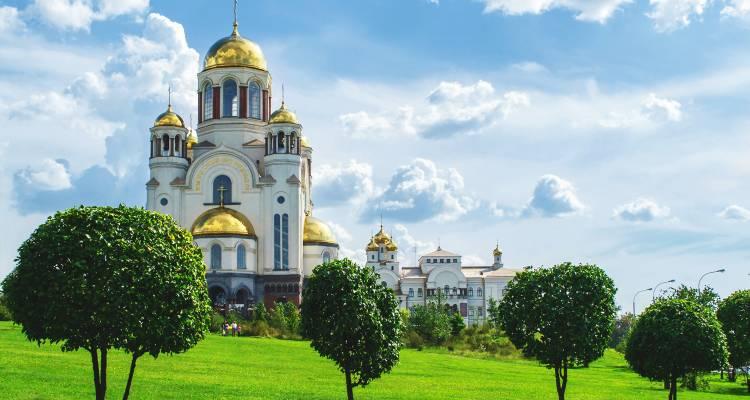
Route of the Romanovs - 10 days
- Learn about the last days of the Romanovs in Yekaterinburg, visiting the sites where Tsar Nicolas II and his family were assassinated and buried
- Straddle two continents at the famous obelisk Europe/Asia border marker in Yekaterinburg
- Experience the Trans-Siberian railway on an overnight train journey from Moscow to Yekaterinburg

New Year's in Moscow - 9 days
- Visit Catherine Palace at Tsarkoe Selo on Christmas Day and marvel at the incredible Amber Room
- Spend a night in Novgorod, an ancient city by the Volkhov River - explore the kremlin, cathedral and other sights and enjoy a traditional Russian banya (sauna)

Back in the USSR - 7 days

Russian Revolution - 9 days
- Visit historic Novgorod, an ancient city which straddles the Volkhov River. Explore the attractive riverside kremlin and experience a traditional Russian banya (sauna)
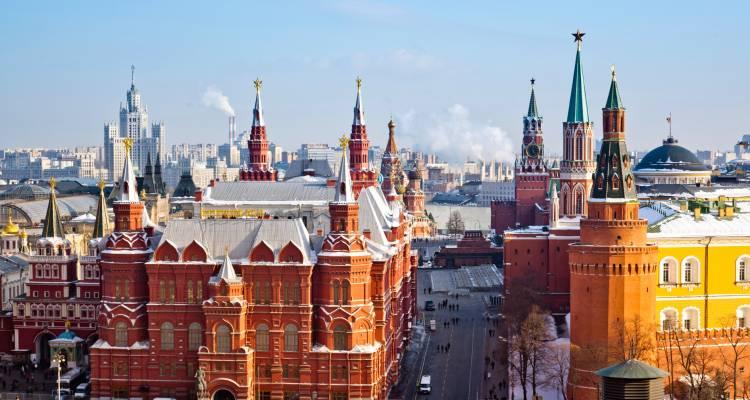
The Snowball - 6 days
- Visit Catherine Palace at Tsarkoe Selo and marvel at the incredible Amber Room
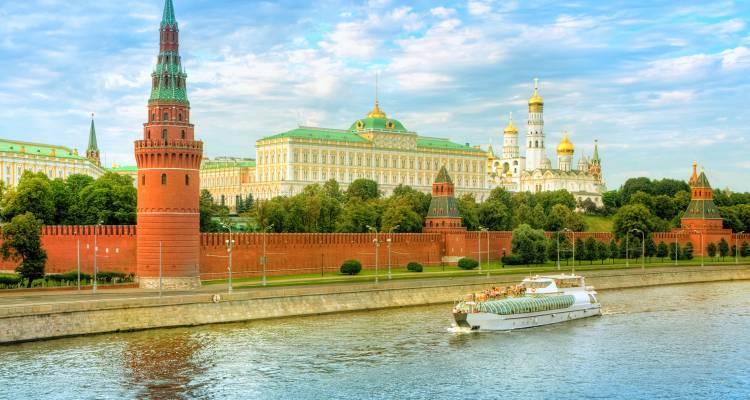
Mood for Moscow - 4 days
- Head underground to visit a Stalinist-era Soviet Bunker on an optional excursion
- Stroll to the vibrant Izmailovo Market, which lies behind the walls of an ancient Kremlin, and shop for an array of souvenirs
Best Moscow Tours by Duration
Tours, Cruises & Private Trips
Best Moscow Tours by Price
Top Moscow Attractions & Experiences
Moscow Tours & Travel Guide
Moscow Attractions & Landmarks Guide
Moscow reviews & ratings, capitals of the north.
some hotels could have been better
It was jam packed with every place I wanted to go and see. I especially love my photo of us setting out on the night time river cruise in St Petersburg and the Peter...
I really did not buy much and what I did buy was small gifts for others .
Johanna-Marie
Good hotels, some better than others. Interesting itinerary
Too rushed. Optional tour rather too short
See all Moscow reviews
Traveling to Moscow, an FAQ
1. Does Travelstride have all the tour operators?
2. How does the Member Savings program save me money?
3. Can I trust the tour operator and trip reviews on Travelstride?
4. What does ‘Stride Preferred’ mean?
City Sightseeing Moscow Hop-On Hop-Off Bus Tour with Optional Cruise

- Hop-on or hop-off at any of Moscow’s main highlights
- Views of Moscow from an open-top, double-decker bus
- Learn about the city with recorded commentary
- Visit Red Square, Alexander Gardens, and more
- Bus pass inclusions: 48 or 72 hour bus pass + walking tour
- Boat pass inclusions: 60 minute boat trip + walking tour
- Bus & Boat pass inclusions: 48 hour bus pass + 60 minute boat trip + walking tour
- Vouchers valid for 12 months
- Hotel pickup and drop-off
- Food and drinks, unless specified
- Location Name: The route begins at Red Square but you can board at any stop
- Wheelchair accessible
- Stroller accessible
- Near public transportation
- Confirmation will be received at time of booking
- Red Route runs from 10:00am - 6:00pm, every 25 minutes. Duration - 60 minutes. First stop - Bolotnaya Square.
- Most travelers can participate
- Green Route runs from 10:00am - 6:00pm, every 60 minutes. Duration - 120 minutes. First stop - Bolotnaya Square.
- Orange Route (currently suspended) runs from 10:30am - 6:30pm, every 30 minutes. Duration - 140 minutes. First stop - Museum of Cosmonautics
- Walking tour runs daily at 10:45am. Duration - 2 hours 30 minutes. Meeting point - Next to monument of Saints Cyril and Methodius.
- Boat tour operates 5th May - 20th October, from 11:30am - 6:30pm. Duration - 60 minutes. Meeting point - Zaryadye Park Pier.
- Mobile and paper vouchers are accepted for this tour.
- Vouchers can be redeemed at any of the stops along the routes.
- Vouchers are valid for 12 months
- For a full refund, cancel at least 24 hours in advance of the start date of the experience.
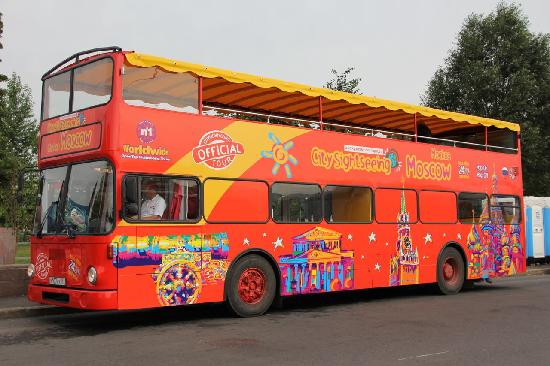
- DebbJ 0 contributions 4.0 of 5 bubbles Great way to get oriented to Moscow We started our Moscow experience with the hop on hop off. It was a great way to get orientated to the city. The additional optional tours were also good, we did the Metro tour which I highly recommend, we also paid for the Kremlin tour. The hop on hop off has three different lines all included. Only fault was the bus was sometimes full and you had to wait for the next one which was about 15 minutes (in the cold). Read more Written January 6, 2020
- UmaDelhi 0 contributions 5.0 of 5 bubbles 2 days are required Very very good audio guides- the voice quality was also good and also the anecdotes of history were brilliant. Russia is truly beautiful Read more Written September 1, 2019
- BeverleyT 0 contributions 1.0 of 5 bubbles Boat trip - TERRIBLE We got on the bus, but couldn’t buy a 1 day ticket. They suggested we do the 1 hour boat trip and said they would drop us to the dock. 1) they dropped us in the wrong place 2) they were lost because of the marathon Then the boat, after we finally found it: 1) stinking fumes, actually gagging 2) no commentary, in fact, no interaction unless you begged 3) offered us 2 for 1 icecreams as they had melted and refrozen as the fridge gets turned off at night Honestly, we enjoyed the afternoon in the boat but spent all of it laughing at just how awful it was!!! The worst thing in Moscow! Read more Written August 18, 2019
- niruDurbs 0 contributions 3.0 of 5 bubbles Not the best value for the price The ticket is quite expensive and covers three different routes in a 24 hour period. The red route is quite exciting and takes about an hour. The bus comes every 10 to 15 minutes. However the other two routes take about two hours each and buses come every 30 to 40 minute period. If the bus is full then you have to wait at the stop for the next bus. So personally I feel that not much can be seen this way. I definitely was not impressed. However it must be noted that one can learn a lot about the history of Moscow Read more Written July 3, 2019
- IrishCueTravel 0 contributions 1.0 of 5 bubbles SLO Motion Not all their fault , but if you plan on trying this Attraction be patient! Traffic is a big problem first and foremost. But to add additional unnecessary delays; the bus stops at each site for 15 minutes at a time or More ! I gave up half way through ( 45 minutes) ; and walked back to the starting point in 10 minutes! Read more Written June 4, 2019
- michael g 0 contributions 1.0 of 5 bubbles Worst hop on/hop off EVER Waited for 40 minutes in the cold rain for a bus that never came... unacceptable. Traffic is so bad that when on a bus the previos day it was barely moving. My advice-get a subway pass and a good travel guide book and do sightseeing on your own! Read more Written October 24, 2018
- Rebecca J 0 contributions 3.0 of 5 bubbles Boat element was excellent We purchased a ticket online for the boat and bus for 2 days. The boat element was wonderful, we saw some amazing parts of Moscow along the river side. The bus element was very disappointing as it only started at 10am and was finished by 6:30pm. It was extremely warm when we were there and it would have been great to do the tour in the cool of the day. There was also no air conditioning in the down stairs part of the bus. They also turned away passengers at one of the stops as the bus was full and there was not another bus for 40 minutes. Read more Written September 26, 2018
- Monismith2014 0 contributions 4.0 of 5 bubbles it was very enjoyable it was very interesting seeing things we saw walking around from the bus. so much more to see. we had a lot better view of the attractions from the height of the bus.also the bus was reasonable slow which gave us time enough for photos. it stopped at sparrow hill for 10 minutes for picture taking Read more Written September 20, 2018
- fati666222 0 contributions 4.0 of 5 bubbles The best way to see Moscow We did both routes but if you have little time then only do the red route.Its very informative and it takes you to the important sights.The staff on the bus are very friendly and helpful. Read more Written August 20, 2018
- adolfo17 0 contributions 3.0 of 5 bubbles The worst hope-on hope-off service I've ever seen Diffiult to understand the route maps and stops. Staff wouldn't help either. Lengthy stops. No air conditioning. Read more Written August 4, 2018
- Peter F 0 contributions 3.0 of 5 bubbles Two Routes There is a short red route which depending on the traffic takes about an hour. The route is generally around the Red Square area. The ear phones were small and sometimes the commentary did not link up with the sites you were seeing. The green bus takes you on a longer route and ours took two and a half hours due to the heavy traffic. I would not recommend this trip unless it is raining or you want to fill in time. The sights we saw were nothing outstanding with plenty of time at certain stops for photos. Also the driver stop for a bite to eat at one stop. Read more Written July 30, 2018
- Bernardo P 0 contributions 1.0 of 5 bubbles Boat Trips Moscow, Russia Yesterday, I booked a boat trip with the GetYourGuide.com web page and was totally horrible, didn’t have audio guide as it shows on the picture-Nobody Talk-. The girl on the picture-light blue bag-ask for 100 Rubles for show her the QR Code while I had the Booking and PIN number cause she must see the vessel name-Didn’t say nothing and after she said board any vessel. I suggest take the trip and pay on site, avoid fake internet pages, there are many other services with a lot of entertainment, don’t take this ones. Read more Written July 14, 2018
- Kathrynowl91 0 contributions 3.0 of 5 bubbles Good way to see some sites We usually do these tours when we travel. They get you round and you see the sight . The traffic is quite heavy so it is a bit slow but there is not a lot they can do about it. We only did the red route. Just a note people don’t queue here when the bus comes it’s a bit of a free for all. Read more Written July 13, 2018
- Daniyal91 0 contributions 3.0 of 5 bubbles Was Ok.! Started our tour of moscow from here, We had got the 2 Day Pass with the boat ride. The route and the map was good but not well managed. The bus didn't stop at many points. Were were unaware a couple of times at what point we were and missed them. Headphones and maps were provided. Would recommend one should check out the route map before going and decide which places to stop in advance, this way one can manage and enjoy the tour more and us it more effectively.! The boat ride was Ok, a little crowded. No guide provided, just a boat ride with restaurant service Read more Written July 12, 2018
- WilliamDyer 0 contributions 1.0 of 5 bubbles Poor service on boat and too many waiting times on buses For the price, you should expect at minimum English speaking tour guides with decent experience, but at least in my case that did not happen both in buses and boats. And in the boat even tough we were 90% English speaking tourist at least, the tour guide spoke 95% of the time in Russia, and only 3 sentences in English, I really counted how many times she spoke in English. And at the end she asks us if we have any questions? Of course I told her I couldn’t ask her anything since I didn’t understand 95% of what she was saying. The boat tour is not worth it, just take the bus that would be my advice. Second minus is the waiting times, in the boat they made us wait an hour before it departed, and in many stops with the buses waiting times of 20-30 minutes. I actually think I lost that day around 2 hours doing nothing. Be careful. Read more Written July 10, 2018
Most Recent: Reviews ordered by most recent publish date in descending order.
Detailed Reviews: Reviews ordered by recency and descriptiveness of user-identified themes such as wait time, length of visit, general tips, and location information.
City Sightseeing Moscow Hop-On Hop-Off Bus Tour with Optional Cruise provided by City Sightseeing Moscow

IMAGES
VIDEO
COMMENTS
Boundary Waters canoe trips. An abundance of route options and easy access for residents across the Midwest makes the Boundary Waters beloved among canoeists. The area's greatest highlight is its unique geography of lakes, some which are interconnected and others which are separated by short overland portages. This is picture-perfect canoe ...
Best Boundary Waters 4-day trips Lac La Croix. Make a run for the border on this 28-mile, out-and-back route starting at entry point 16. Sprawling Lac La Croix is stunning with its fleet of islands, and along the way you'll touch on the more intimate surroundings of Nina Moose Lake and Lake Agnes.
Stone Harbor Wilderness Supply. Based in Grand Marais, Stone Harbor Wilderness Supply offers Boundary Waters canoe day trips starting at $150 per person and a four-day guided kayak camping trip on sprawling Saganaga Lake starting at $725 per person. Photo: Britta Bjur // @brittabjur.
Your go-to BWCA outfitter for canoe trips in Ely, Minnesota since 1984. For over 40 canoe trip seasons we have been one of the leading Boundary Waters outfitters in Ely, Minnesota . We outfit BWCA canoe trips with top-quality gear and meals for both the Boundary Waters Canoe Area Wilderness in northern Minnesota and Quetico Park in Canada.
The Boundary Waters Canoe Area Wilderness (BWCAW, or simply BWCA) is our nation's only large lakeland wilderness, where travel during the ice-free months is primarily via canoe. At over 1 million acres, the area remains the largest wilderness east of the Rockies and north of Florida's Everglades, and the storied Boundary Waters remains the ...
There are many ways to explore the Boundary Waters, but the two most popular modes of travel are hiking and canoeing. Canoeing. Northeastern Minnesota is created for canoeing. This is the best canoe country in the United States, a place where each year thousands of lives are transformed. Hiking
Planning a Boundary Waters canoe trip in the Boundary Waters Canoe Area Wilderness (BWCA) involves navigating a labyrinth of over 1,000 lakes and islands. Located on the Minnesota/Canada border, I've made countless trips to the BWCA ever since I was a kid and it always delivers when I want a quiet week filled with great views and adventure.
The Boundary Waters Canoe Area Wilderness - BWCA, protected as a true American wilderness, has changed little since the glaciers melted. Canoeing and fishing opportunities are nearly endless on the more than 2,000 lakes and streams found within the forest. With 1,500 miles of canoe routes, nearly 2,200 designated campsites, and more than ...
Family Super Saver Canoe Trip Package. Each of the Boundary Waters canoe trips packages comes with canoes, all the camping equipment, fine food, maps, and more, right down to the paper toweling and TP. That is why they are called "complete" packages. You bring your personal clothing and hygiene products, a first aid kit, your rod, reel, and ...
We're experts at the trip planning process, and we're happy to help! Reach us with our online contact form, at [email protected], or by phone at 218-343-7951. Answers to frequently asked questions, tips and suggestions for planning a successful Boundary Waters (BWCAW) canoe trip from the experts Ely Outfitting Company.
We can help you seek out whatever has you gravitating to the Boundary Waters, show you added beauty and share with you the history of this mesmerizing land along the way. Contact Moose Track Adventures for superior Boundary Waters Canoe Guide Services in Ely today at 218-265-4106. Learn More About Your Hosts. Ely, MN Guided Fishing Trip Expert.
Our High Adventure Boundary Waters trips are 5 to 14 day wilderness canoe camping experiences. Typical treks cover 25 to 100 miles. You will travel through the Boundary Waters Canoe Area in Minnesota or Ontario's Quetico Park. Our High Adventure Expedition Specials may be set-up to include both areas.
The Boundary Waters Canoe Area Wilderness is a special place. Whether you are a beginner or an expert, we can help you have a successful canoe trip in Minnesota's famous BWCA Wilderness. For over 60 years, our family has been pleased to offer you cordial, personal service. Address: 4620 Sawbill Trail, Tofte, MN 55615 Phone: 218-663-7150 www ...
Plan A Boundary Waters Canoe Trip. Navigating the Wilderness: 10 Essential Steps for Planning Your Boundary Waters Canoe Adventure. Step 1: Choose Your Dates. Step 2: Research Permit Requirements. Step 3: Select an Entry Point. Step 4: Plan Your Route.
See trip details for canoeing the Boundary Waters in Minnesota, one of 100 best American adventure trips from National Geographic. If you're planning to rob a bank in the Midwest, arguably your ...
12. Food. Pot Of Wild Edible Plantain. When it comes to camping in the Boundary Waters Canoe Area Wilderness, it is essential to bring the right type of food. Olive oil, canola oil (for fish), honey, and powdered greens are all excellent options for adding healthy fats and nutrients to your meals.
On this map you can see the details of the longest and most classic of the Flotilla Radisson boat tours: 2. Companies that do boat tours on the Moskva River. There are many companies that do cruises on the Moskva River, but the 4 main ones are: Capital River Boat Tour Company (CCK) Mosflot. Flotilla Radisson.
This newly built home sits on nearly three acres of lakefront property in the Boundary Waters. Recently listed with Z'Up North Realty for $1.295 million, this home is located north of Ely at 14026 ...
63 Moscow trips. Compare tour itineraries from 45 tour companies. 308 reviews. 4.7/5 avg rating. Choose your trip style: Design custom trip. Group Tour. Private Guided. Small Group. River Cruise.
City Sightseeing Moscow Hop-On Hop-Off Bus Tour with Optional Cruise. €40.19. Moscow Scenic River Cruise with Guide. €174.36. Moscow Diorama and River Sightseeing Cruise. €91.64. Gorky Park and River Cruise. €91.64. Metro Tour and Boat Trip of Moscow River.
About. It can be hard to see the highlights of Moscow in a day or two, but this hop-on hop-off City Sightseeing open-top bus tour makes it easy and convenient. Take in views of the city while listening to recorded commentary on the bus. Hop off at any of the stops, including Red Square, the Big Stone Bridge, and Pushkin Fine Arts Museum.